
بسم اهلل الرحمن الرحيم
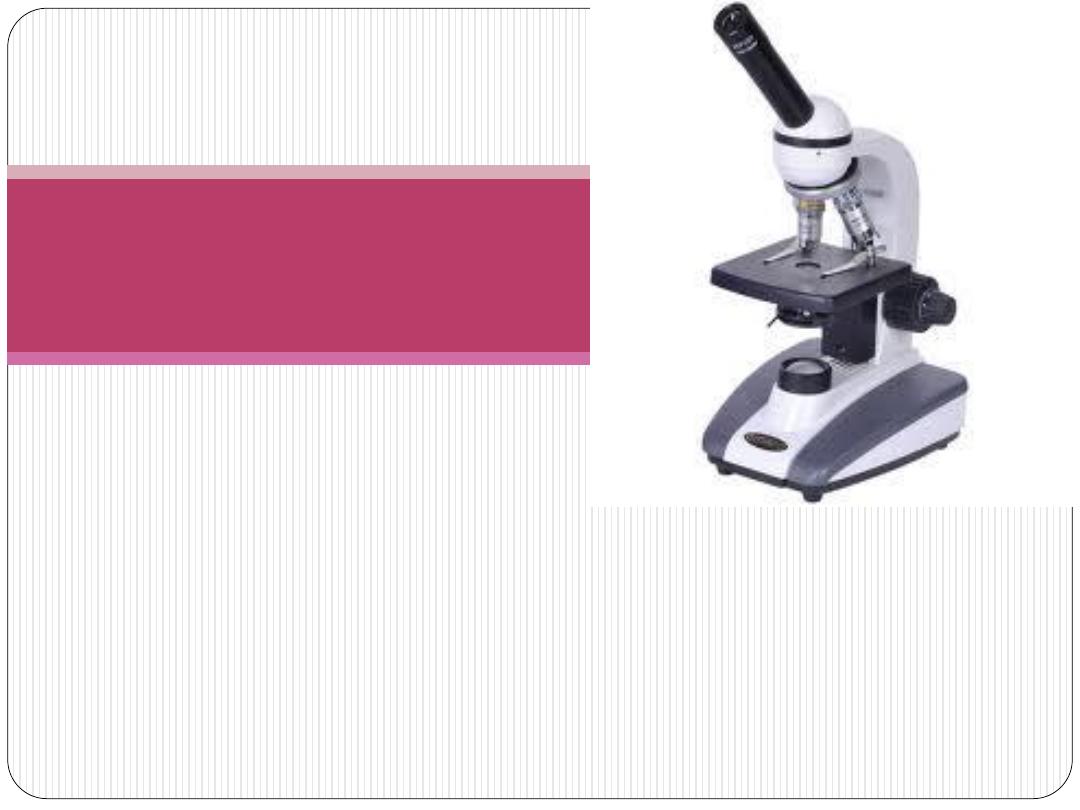
Prof. Dr. Huda Al-khateeb
Head of Histology Section/Dept. of Anatomy
Head of Quality Assurance & Academic Performance
College of Medicine/Univ. of Baghdad
SKIN
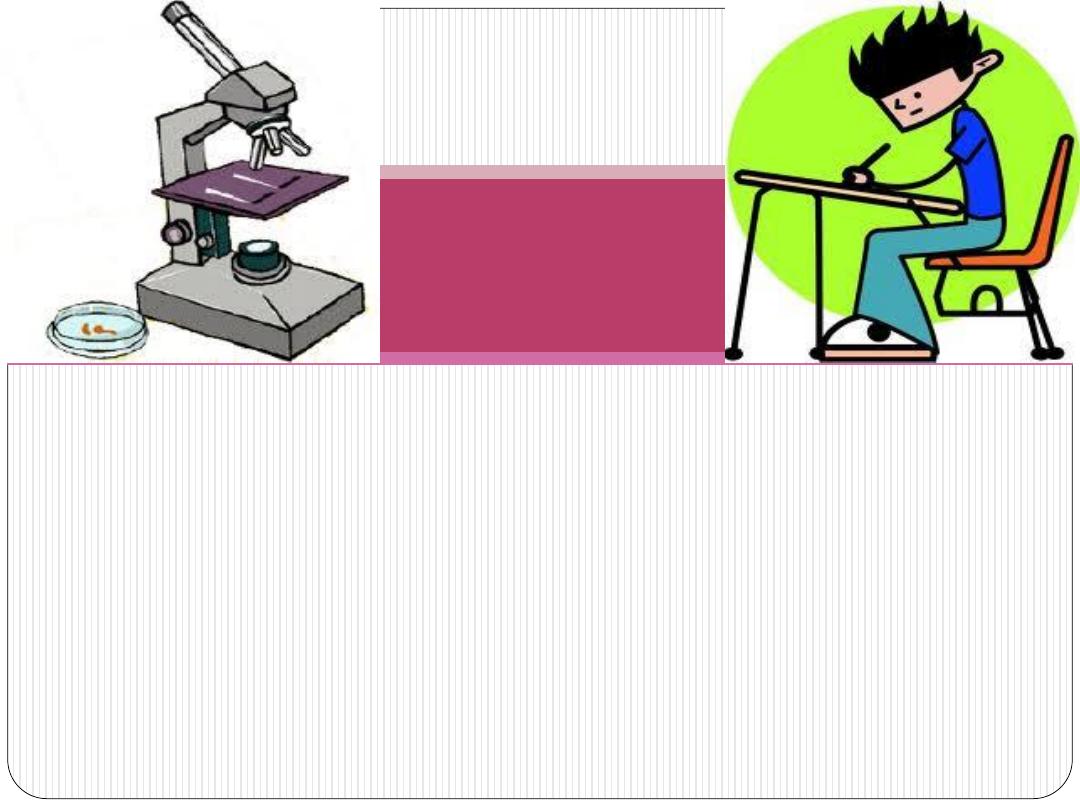
By the end of this lecture, the student should be able to:
1.
List the layers of skin
2.
Describe the types of cells and tissues present in
epidermis and dermis
3.
Discuss the types of keratinocytes and non-
keratinocytes
4.
Recognize some related pathological conditions
objectives

15–20% of total body weight
What is the heaviest organ in the
body?

1.5–2 m
2
What is the largest organ in the
body?
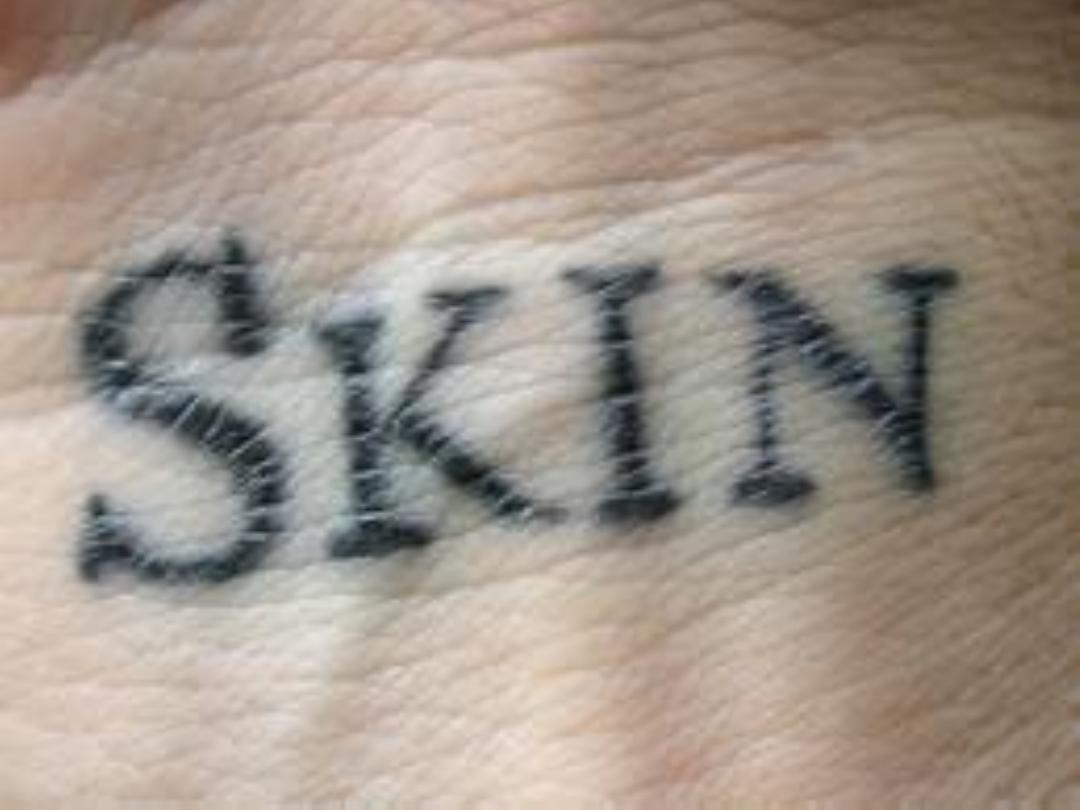
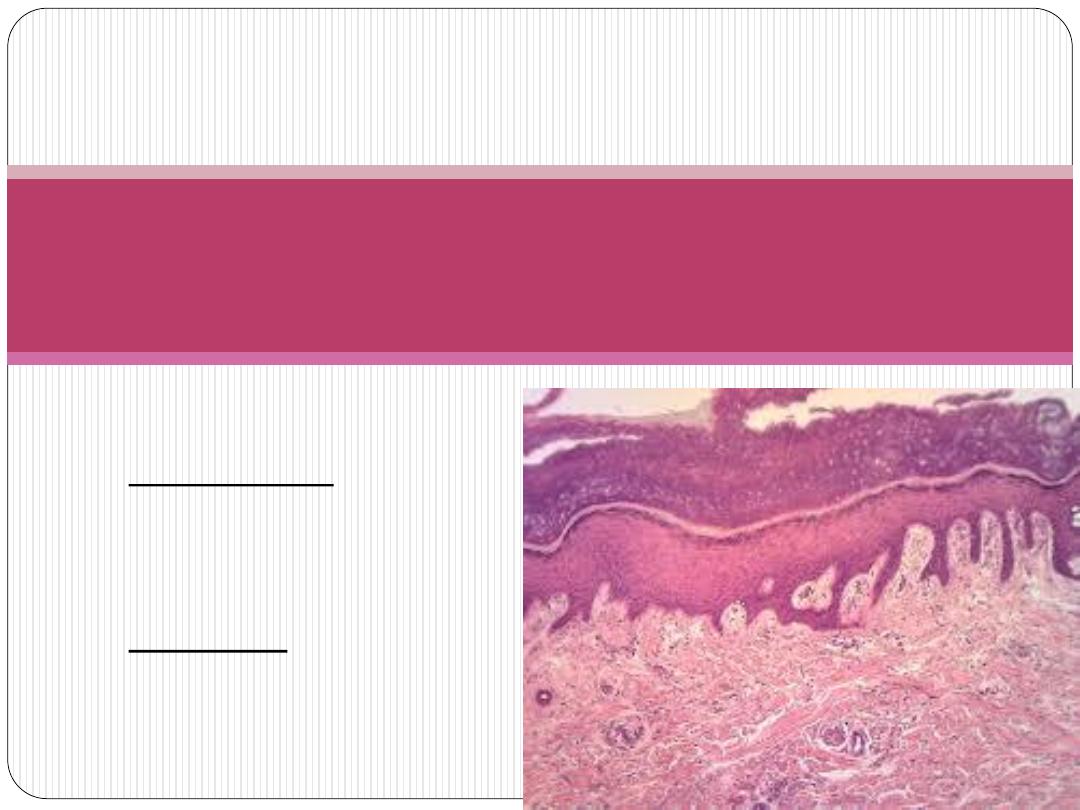
Composed of:
, an
epidermis
) the
1
(
epithelial layer of
ectodermal
origin
, a layer of
dermis
) the
2
(
mesodermal
connective tissue
origin
the integument (L. integumentum,
covering) or cutaneous layer
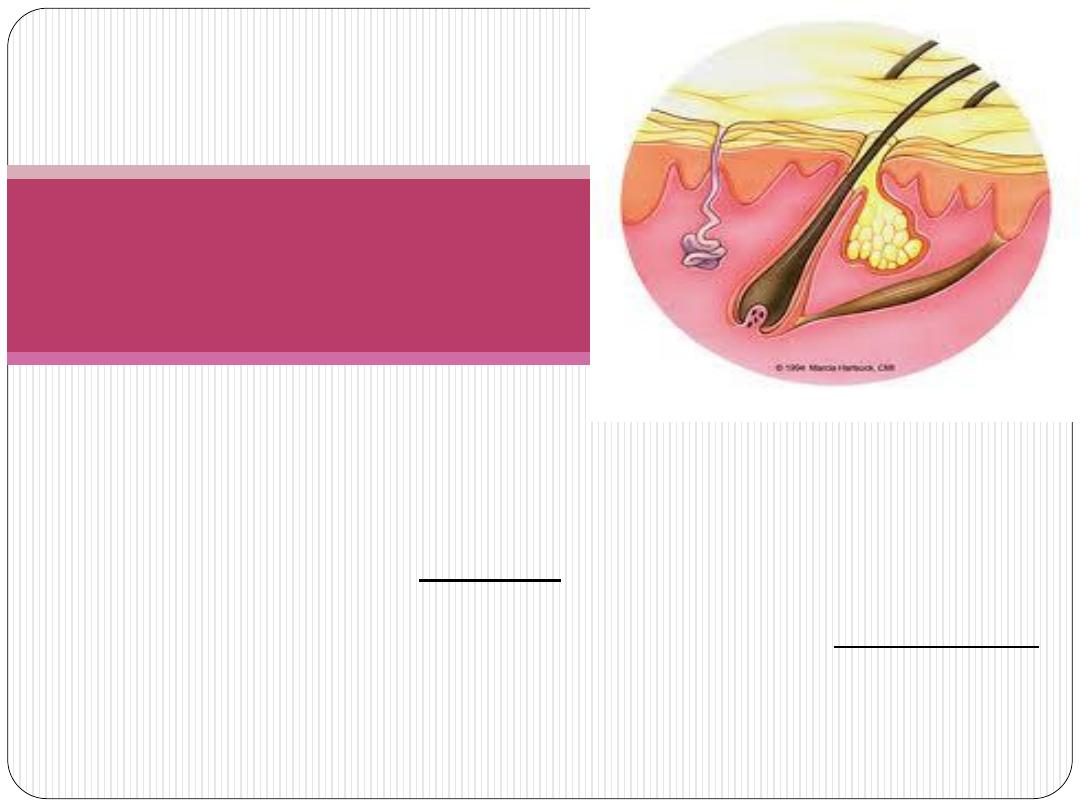
The boundries between dermis and epidermis is
irregular
papillae
called
dermis
* projections of the
epidermis
of the
evaginations
with
digitate
-
* inter
known as
epidermal ridges
.
Dermo-epidermal
Junction
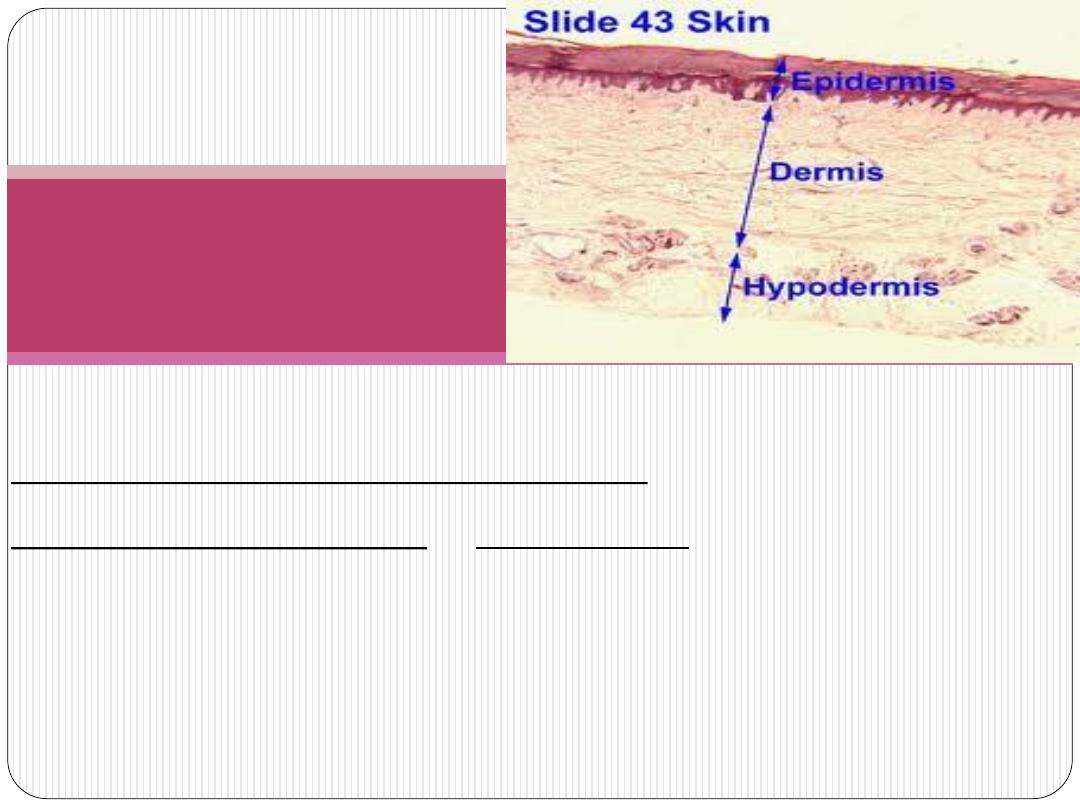
Beneath the dermis lies the
superficial fascia (of gross anatomy)
under, +
hypo,
(Gr.
hypodermis
or
subcutaneous tissue
derma, skin), a loose connective tissue that may contain
pads of adipocytes.
Hypodermis binds skin loosely to the underlying tissues
hypodermis
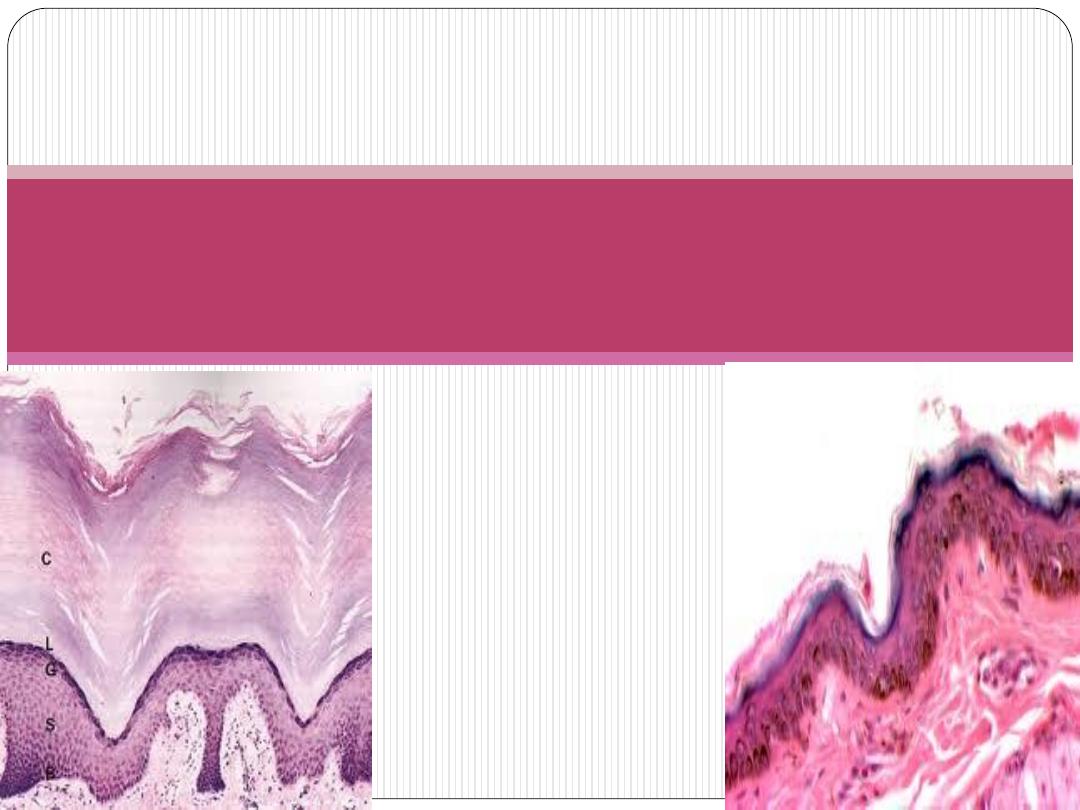
Thick skin
(Palm & Sole)
Thin skin
(Rest of the body)
Skin

.
Protective
(1)
physical barrier
against thermal and mechanical insults such as
frictional forces and against most potential pathogens.
(2)Microorganisms that do penetrate skin alert resident
lymphocytes and
antigen-presenting cells
of skin and an immune response is mounted.
(3)The dark pigment
melanin
in epidermis protects cells against ultraviolet
radiation.
(4)
permeability barrier
against excessive loss or uptake of water.
drugs such as certain
lipophilic
allows some
selective permeability
Skin's
steroid hormones and medications to be administered via skin patches.
.
Functions of
skin
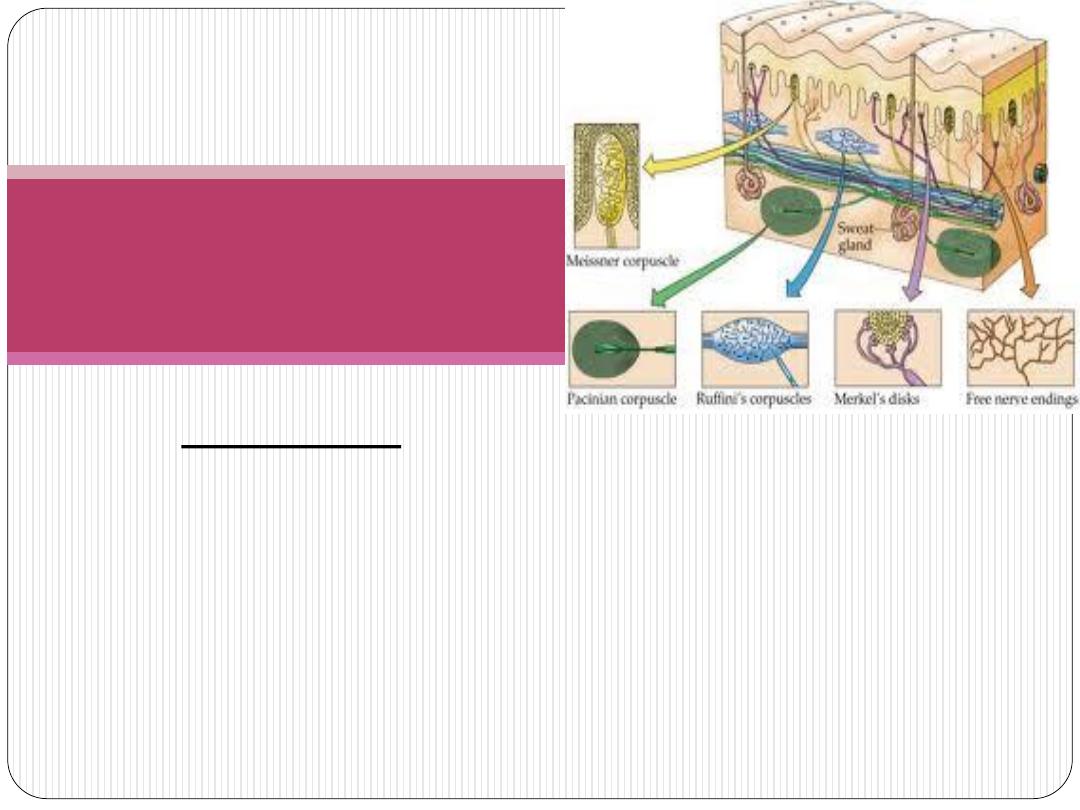
. Many types of sensory
Sensory
receptors
allow skin to constantly monitor
the environment and various
mechanoreceptors with specific locations in
skin are important for the body's
interactions with physical objects.
Functions of the
skin

. A constant
Thermoregulatory
body temperature is normally more easily
maintained thanks to the skin's
insulating
components
(eg, the fatty layer and hair on
the head) and its mechanisms for
accelerating
heat loss
(sweat production
and a dense superficial microvasculature). §
Functions of the skin

. Cells of skin
Metabolic
synthesize
vitamin D
3
, needed in calcium
metabolism and proper bone formation,
through the local action of UV light on the
vitamin's precursor. Excess
electrolytes
can
be removed in sweat and the subcutaneous
layer stores a significant amount of
energy
in the form of fat.
Functions of the skin

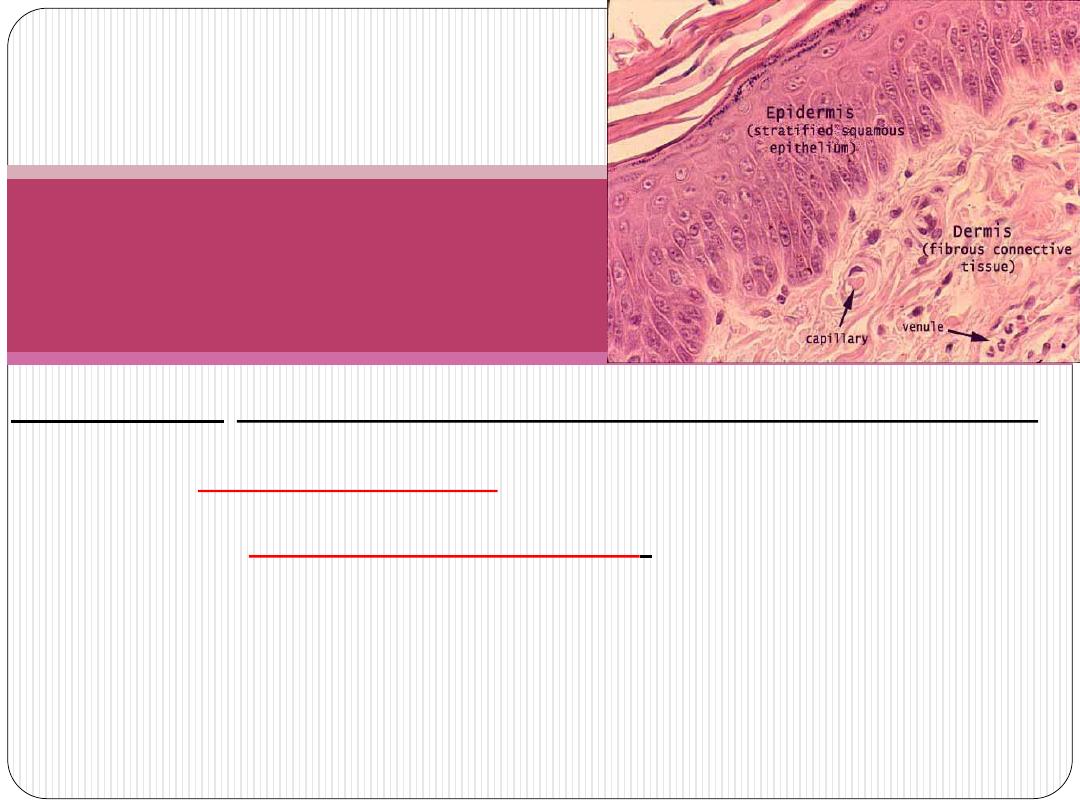
keratinized epithelium
squamous
stratified
keratinocytes
Major cells :
:
keratinocytes
-
Non
Other cells are
(1)pigment-producing
melanocytes
,
(2)antigen-presenting
Langerhans cells
,
(3) tactile epithelial cells
Merkel cells
Epidermis
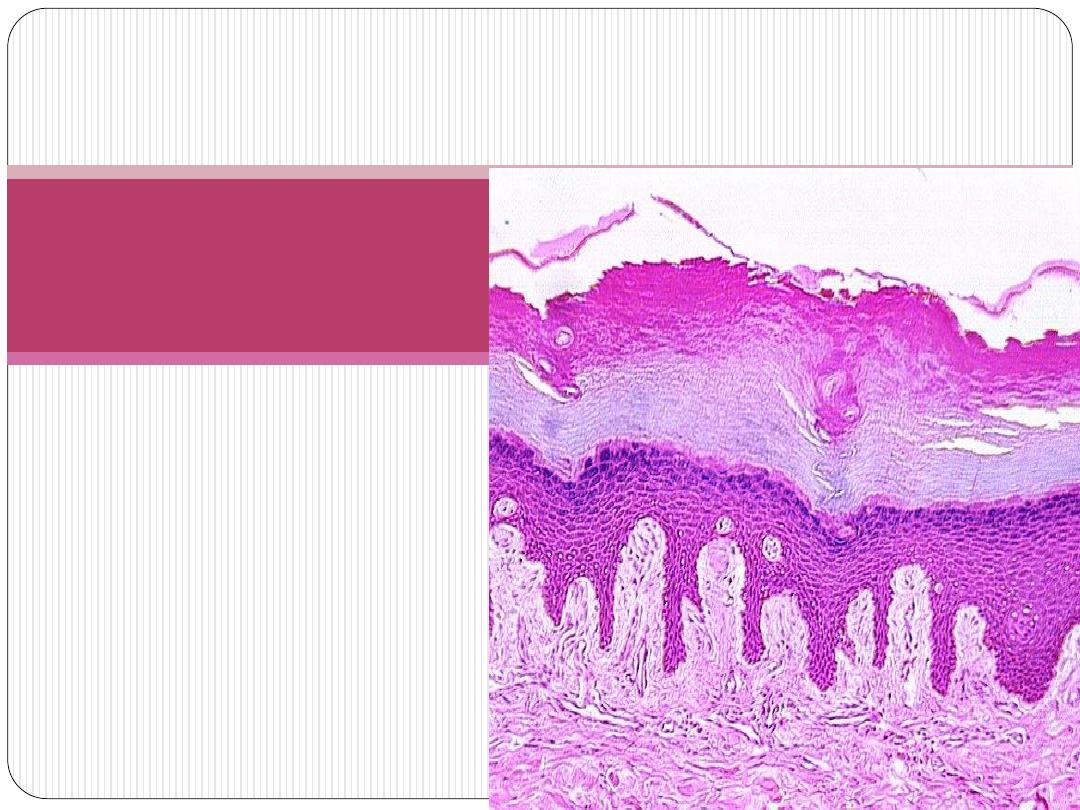
Composed of 5 layers
(Keratinocytes):
Stratum basale
Stratum spinosum
Stratum granulosum
Stratum lucidum
Stratum corneum
Thick skin
epidermis
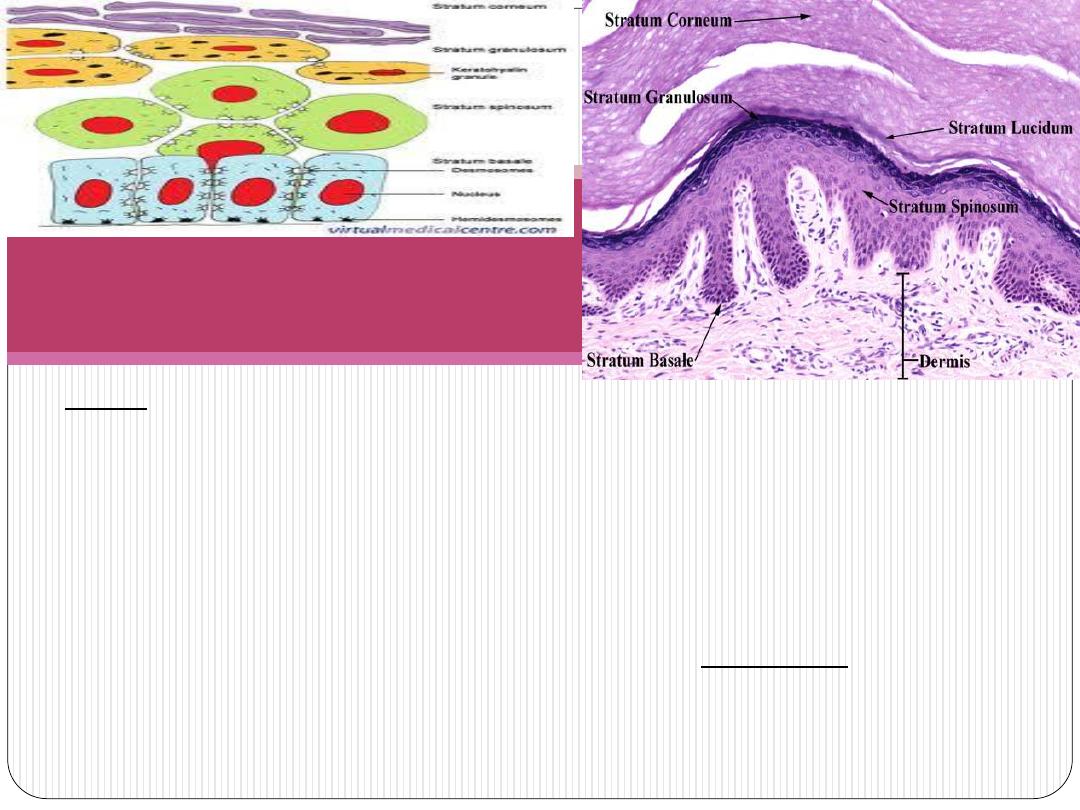
layer of basophilic columnar cells on the basement membrane at
single
)
1
(
the dermo-epidermal junction.
(2)Hemidesmosomes
in the basal plasma lemma bind these cells to the
basal lamina
(3)
Desmosomes
bind the cells together from their lateral wall .
(4)This layer is characterized by intense
mitotic activity
and is responsible
for constant production of epidermal cells.
, depending on
days
30
–
15
)The human epidermis is renewed about every
5
(
age, the region of the body, and other factors.
(6)All keratinocytes in the stratum basale contain
intermediate filaments
composed of keratins.
Stratum basale
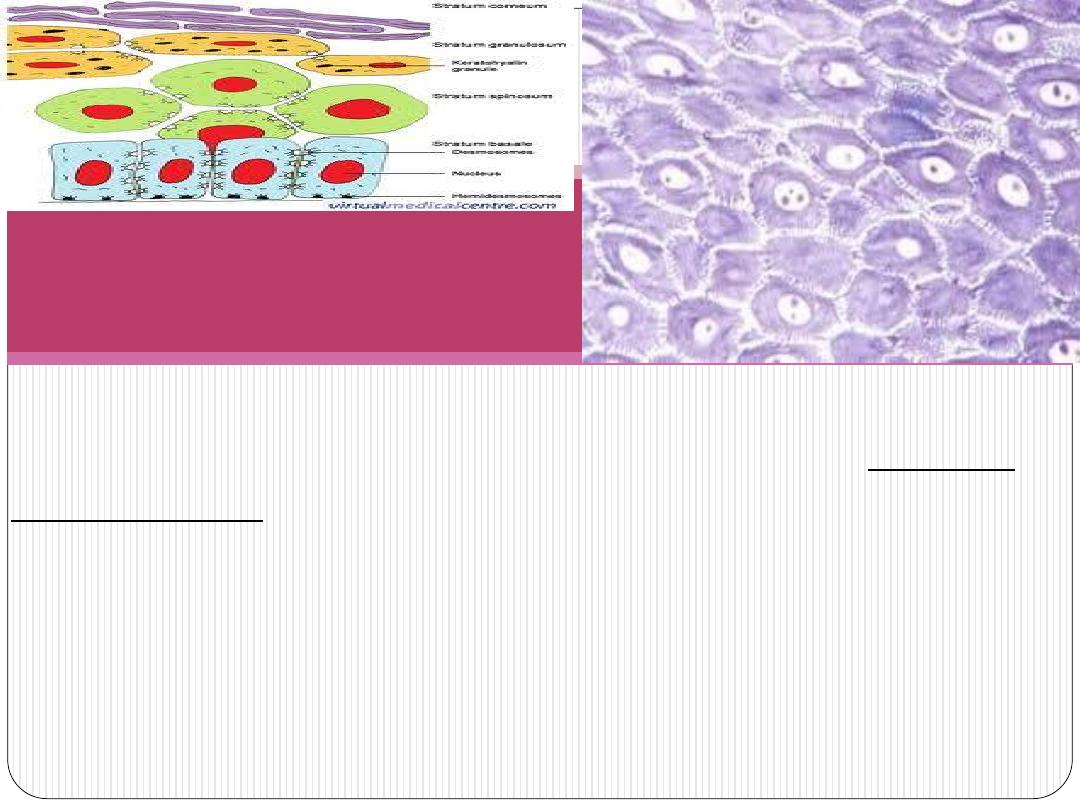
(1)the thickest epidermal layer, consists of polyhedral cells having central nuclei.
stratum
are called the
spinosum
+ lower layers of stratum
basale
)Stratum
2
(
.
germinativum
(3)The keratin filaments form bundles called
tonofibrils
which terminate at
desmosomes.
(4)Cytoplasm has short cellular extensions around the tonofibrils, leading to the
appearance of many short
spines
or
prickles
at the cell surfaces.
(5)It is thicker in areas subjected to continuous friction and pressure (such as the
soles of the feet)
stratum spinosum
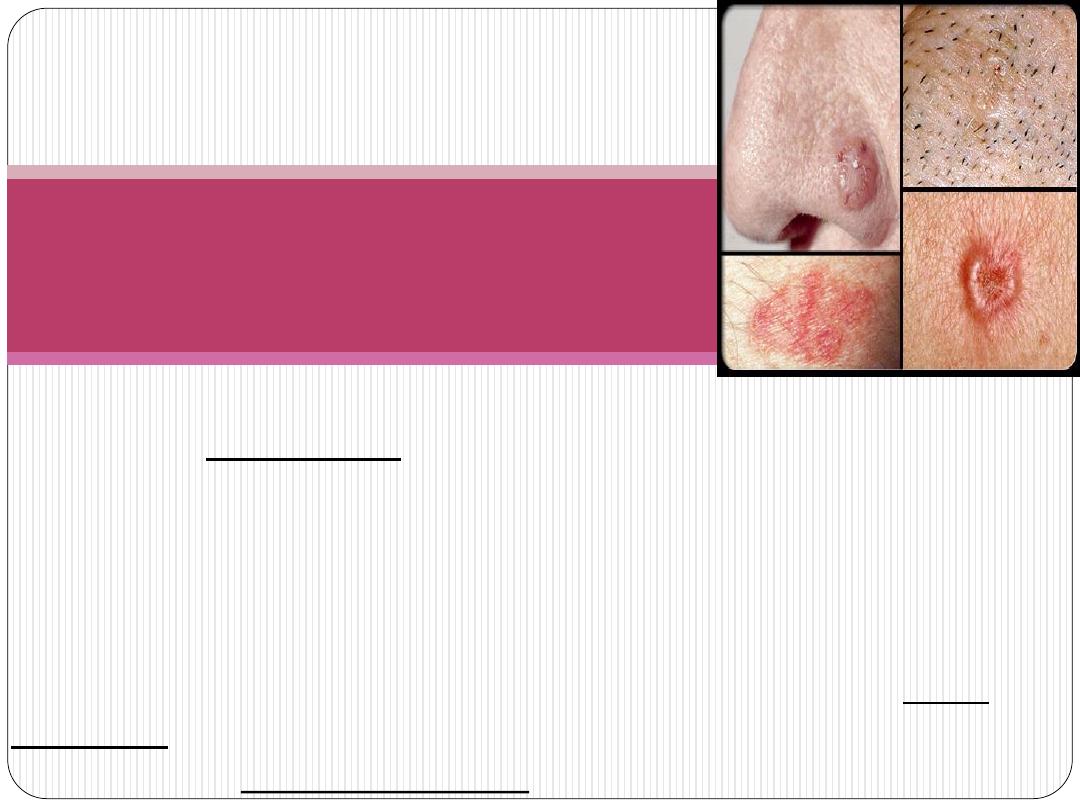
are of the skin.
cancers
of all
one third
In adults,
Most of these derive from cells of the basal or spinous
layers, producing, respectively,
basal cell carcinomas
and
squamous cell carcinomas
.
-
fair
Skin cancer shows an increased incidence in
individuals residing in regions with high
skinned
.
solar radiation
amounts of
MEDICAL APPLICATION
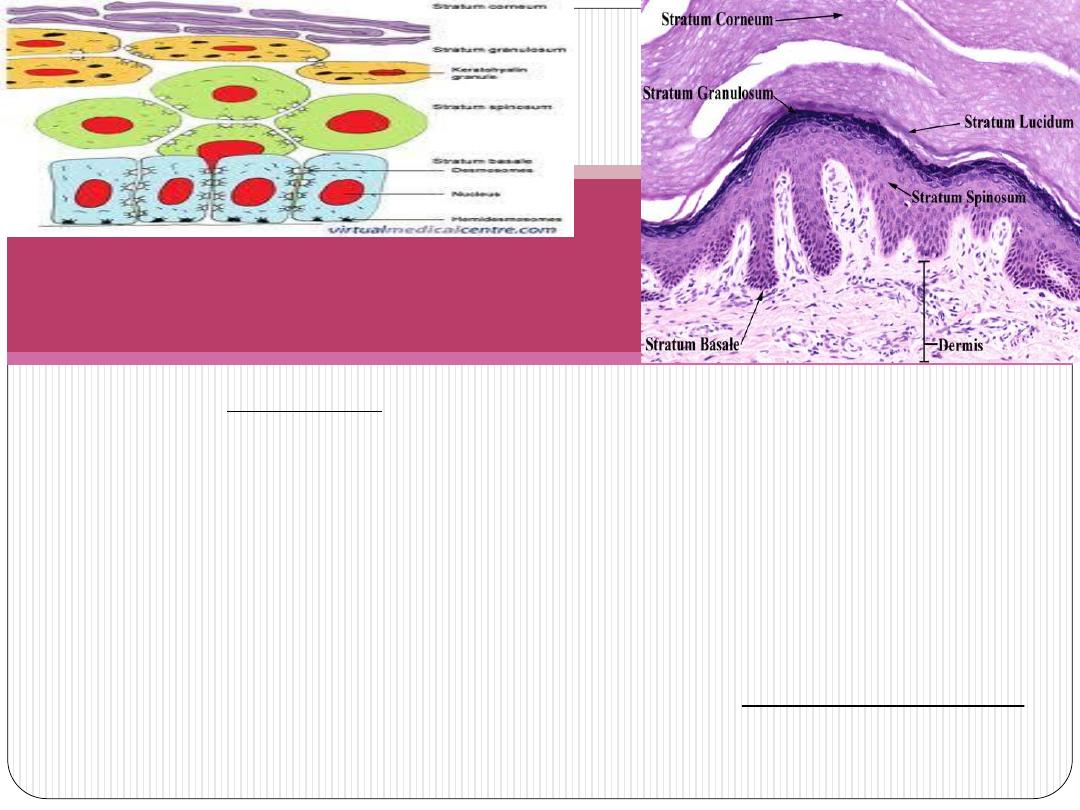
of flattened polygonal cells.
layers
5
–
3
) consists of
1
(
(2)Their cytoplasm is filled with intensely basophilic
keratohyaline
granules
. These structures are
not membrane-bound
and consist of
dense masses.
(3)Other characteristic features are the
membrane-coated
lamellar
granules
, (seen by TEM)composed of various lipids. Lamellar
granules undergo exocytosis, discharging their contents into the
intercellular spaces of the stratum granulosum. this lipid-rich
epidermal barrier
material produces sheets that envelop the cells (
against the loss of water from skin and barrier to penetration by most
foreign materials)
.
stratum granulosum
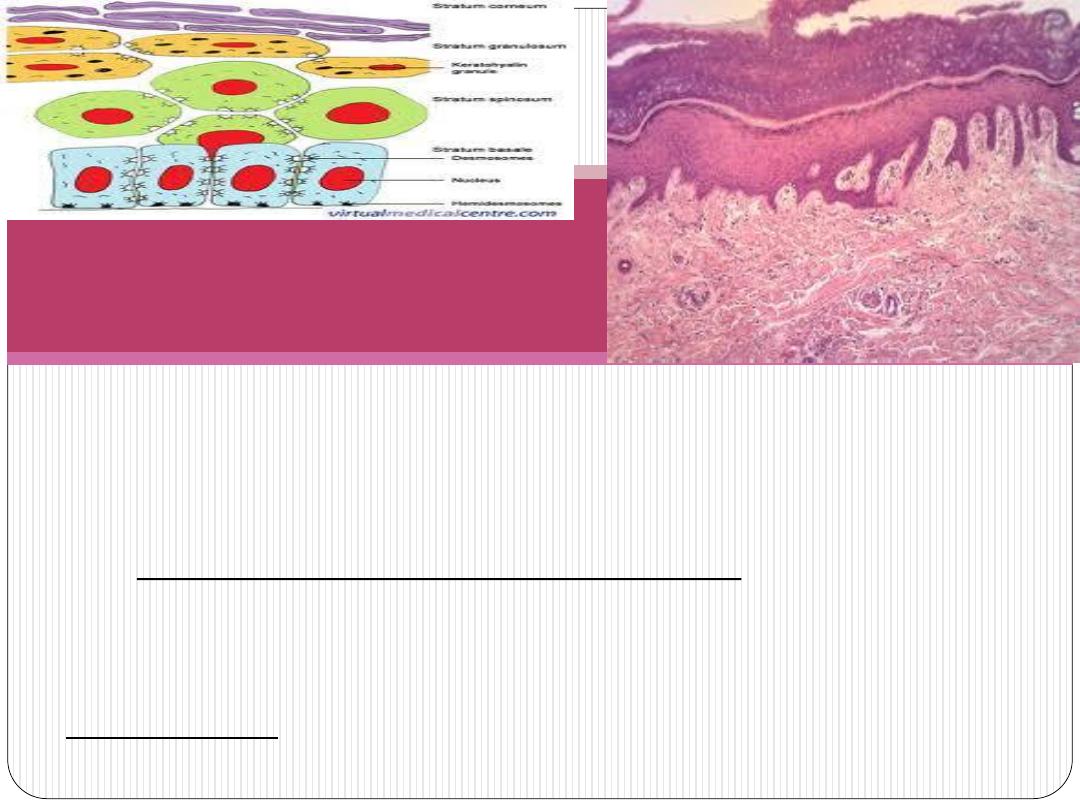
(1)is only seen in
thick skin
(2) it consists of a thin, translucent layer of extremely flattened
eosinophilic cells.
nuclei and organelles have been lost
)The
3
(
(4) the cytoplasm consists almost only of densely packed
keratin filaments
embedded in an electron-dense matrix.
are still evident between adjacent cells.
Desmosomes
)
5
(
Stratum lucidum
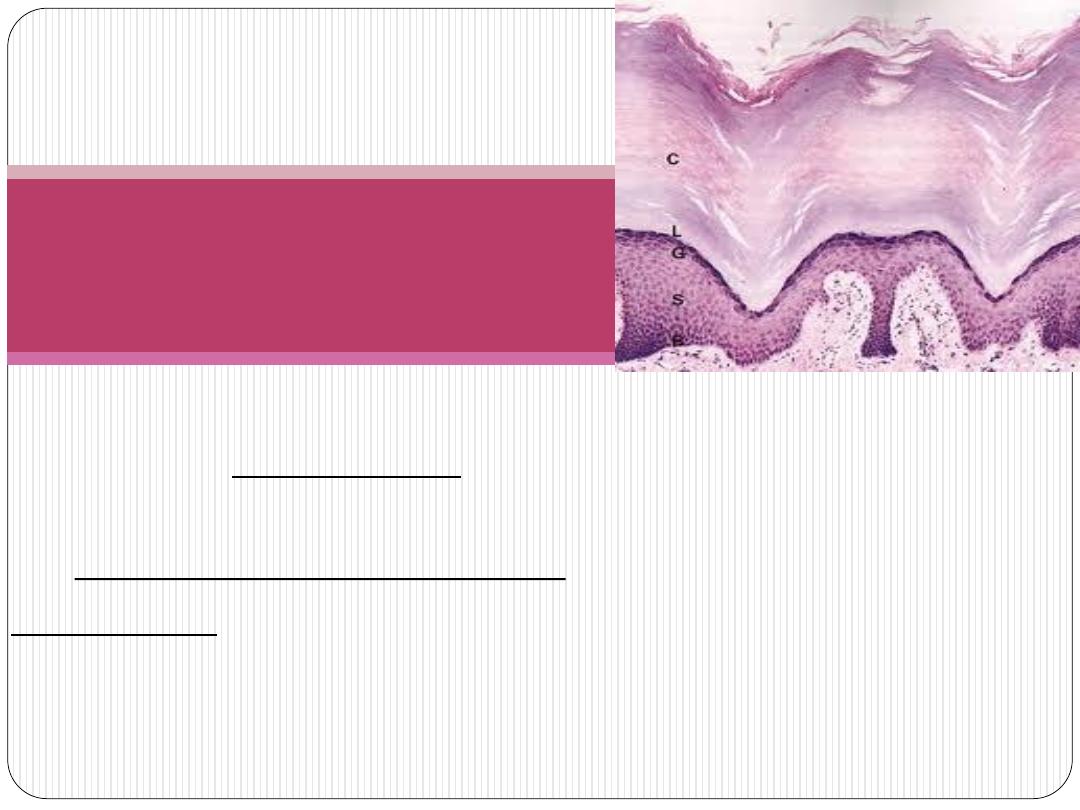
(1)consists of 15–20 layers
keratinized cells whose cytoplasm is
nonnucleated
) flattened,
2
(
filled with filamentous
keratins
.
thickened plasma membranes
)
3
(
cells
cornified
,
horny
or
squames
are called
*These cells
* These cells are continuously shed at the surface of the stratum
corneum
.
Stratum corneum
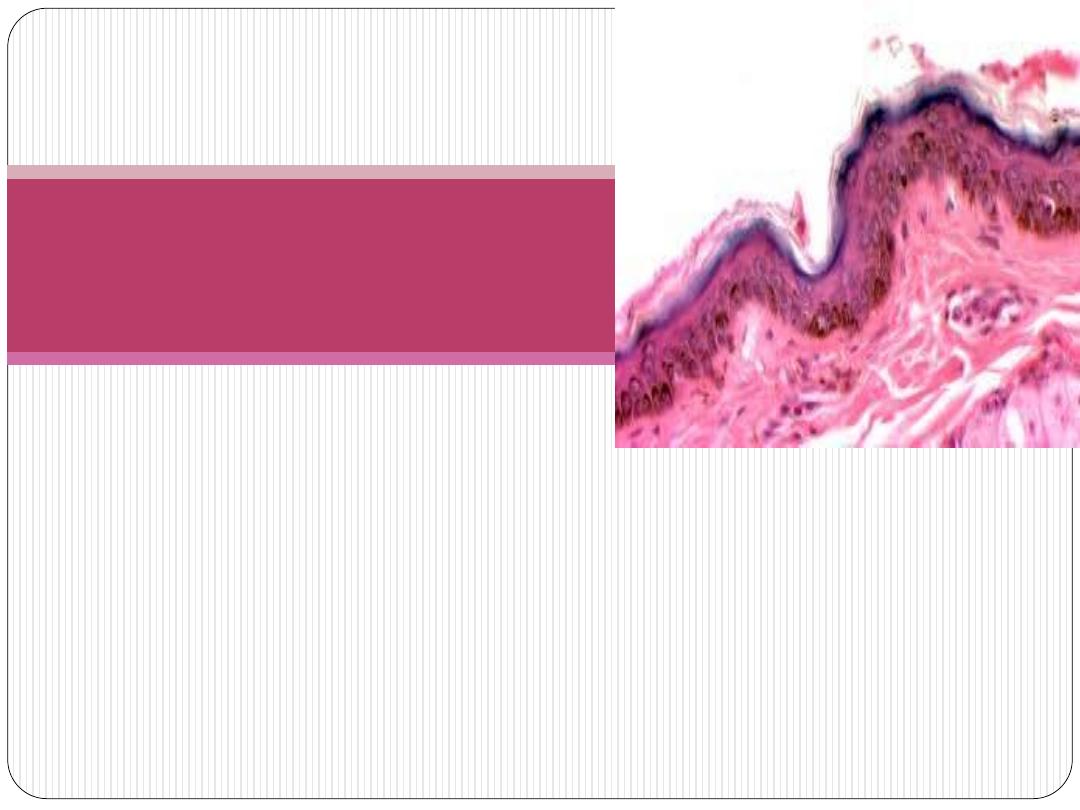
(1)No stratum lucidum (4 layers only)
(2) Stratum spinosum, granulosum and corneum are thinner
Thin skin epidermis
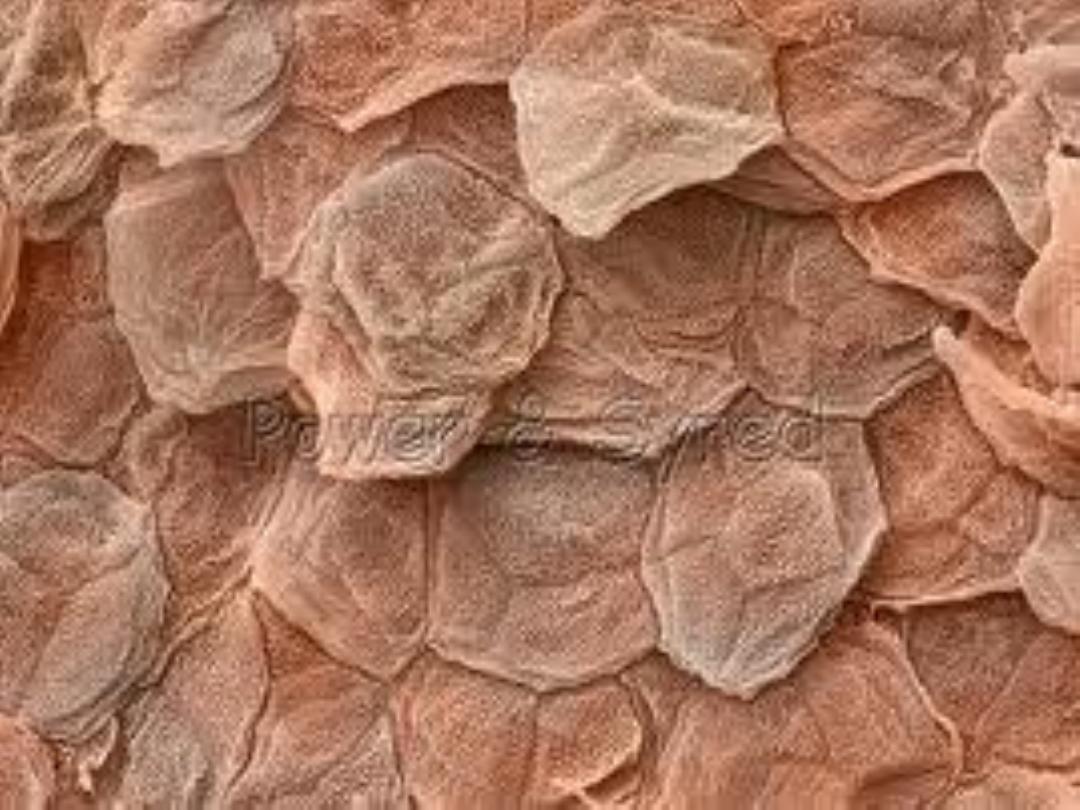
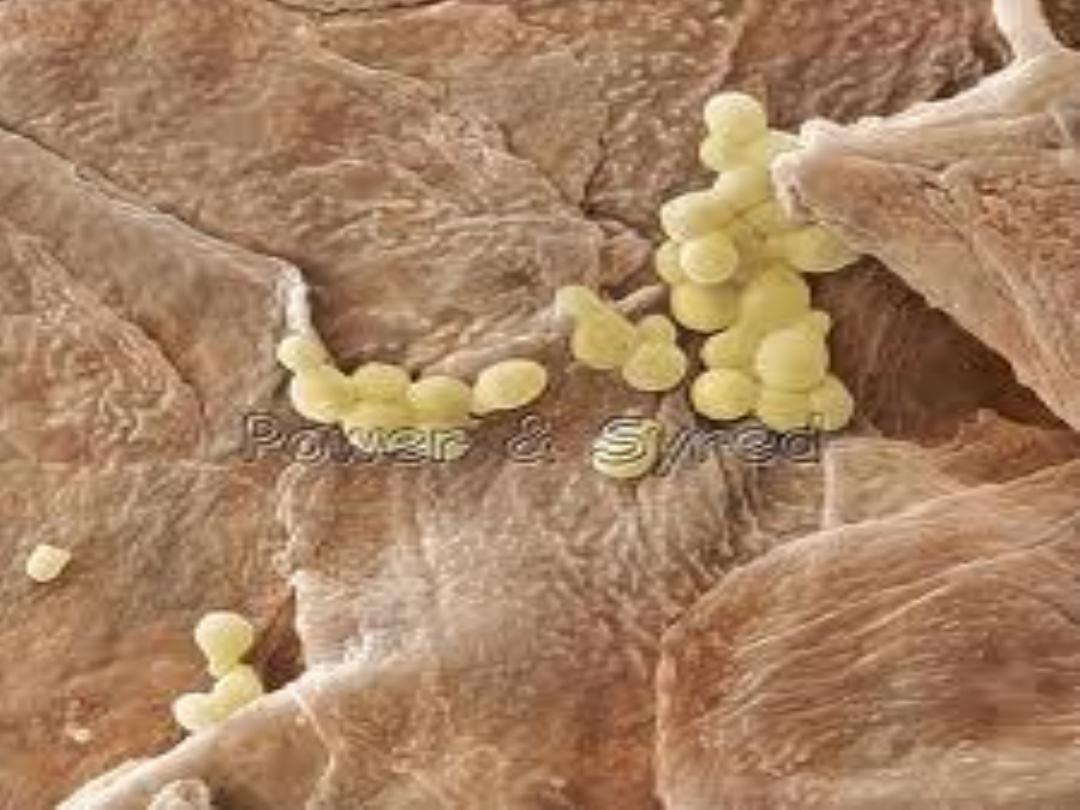
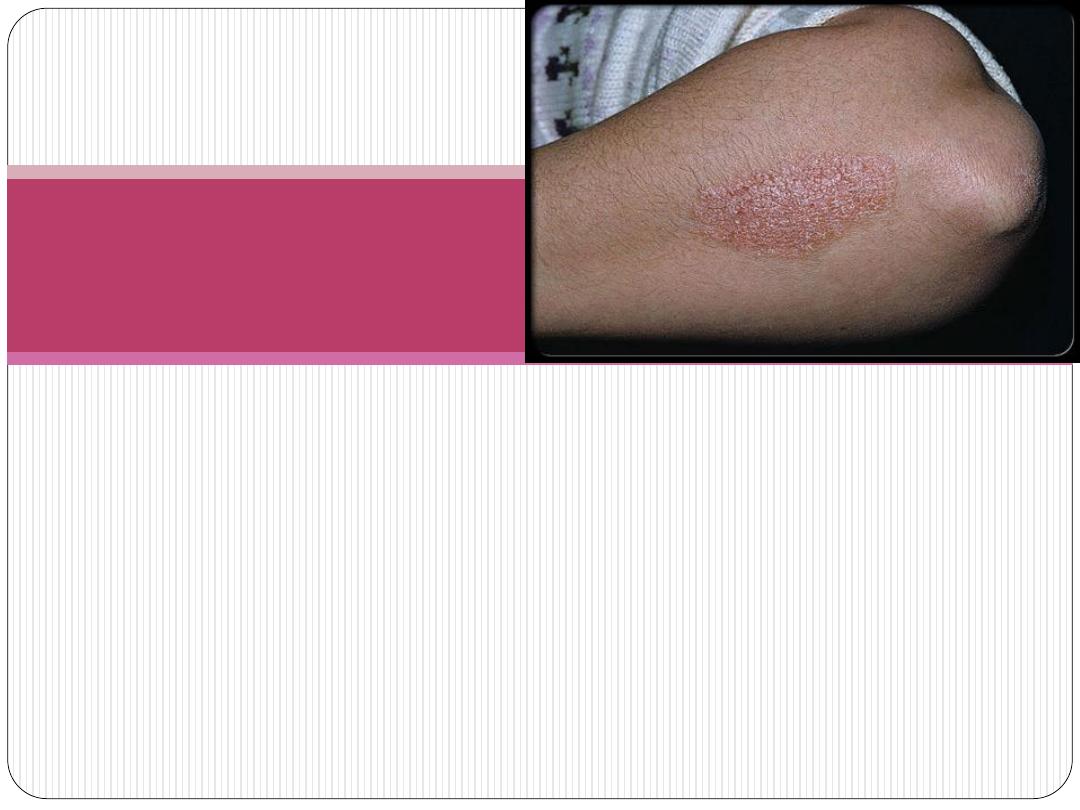
Psoriasis
, a common skin disease, there is an increase in
the number of proliferating cells in the stratum
basale
and the
stratum
spinosum
as well as a decrease in the cycle time of these
cells. This results in
(1)greater epidermal thickness
(2) more rapid renewal of epidermis
(3)abnormal keratinization with a defective skin barrier.
MEDICAL
APPLICATION
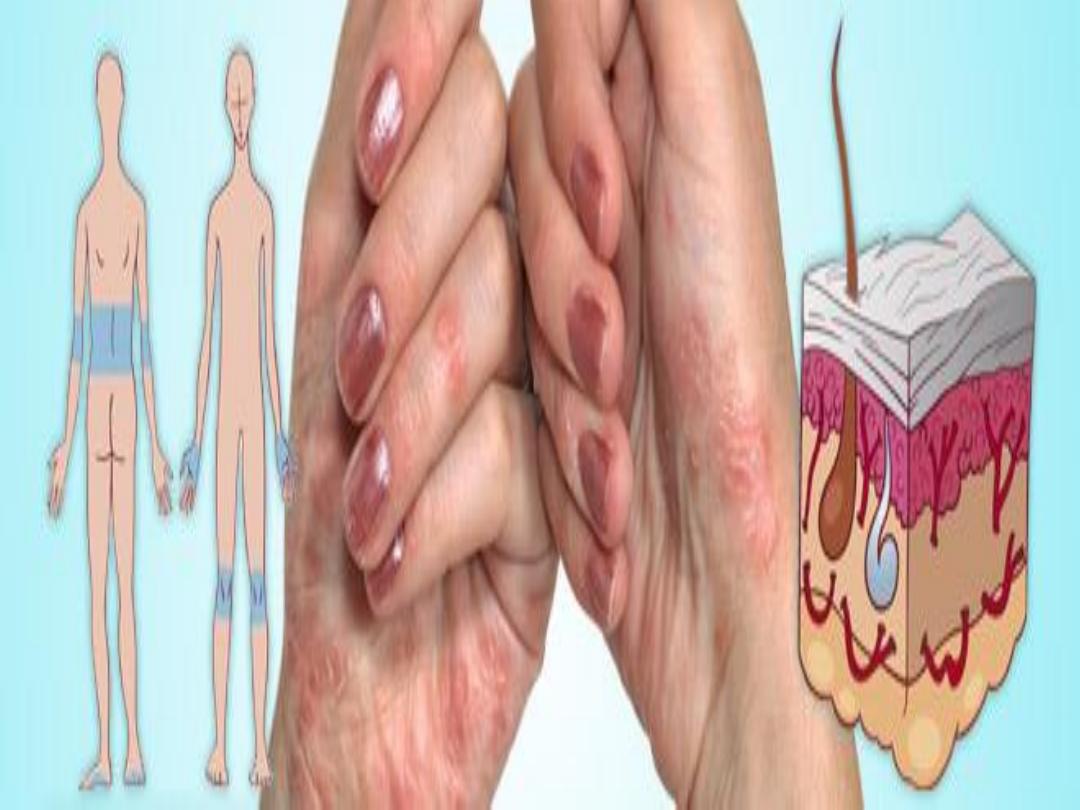
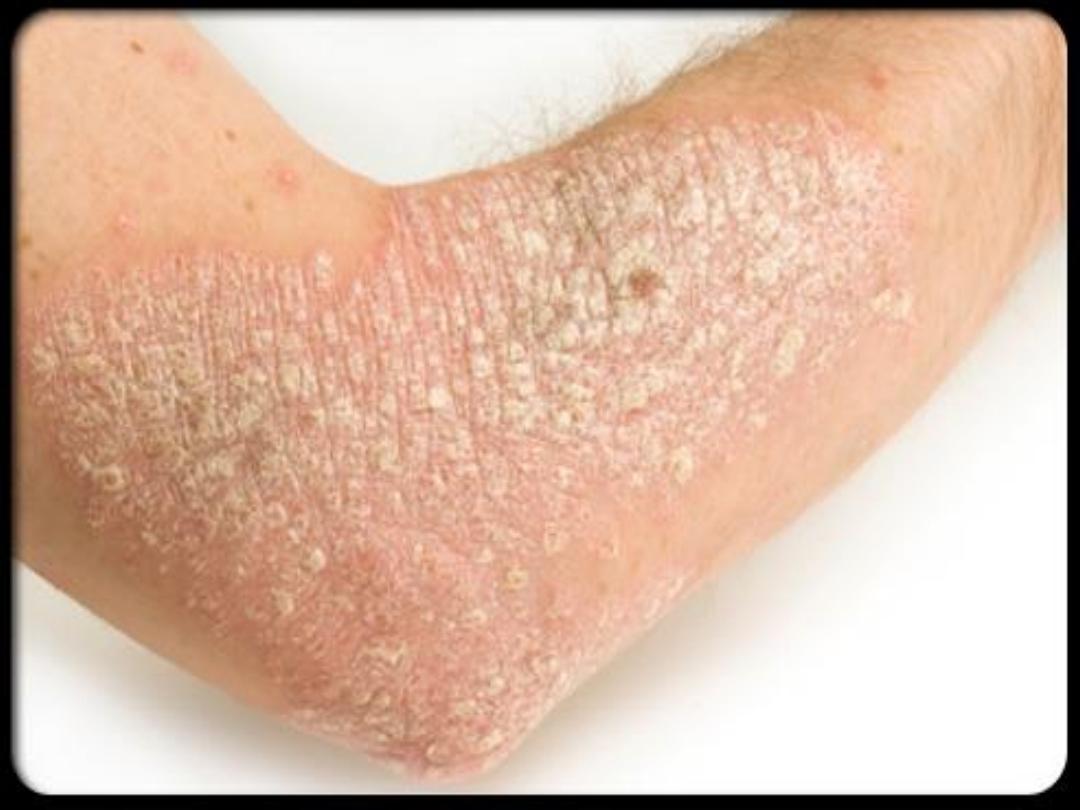

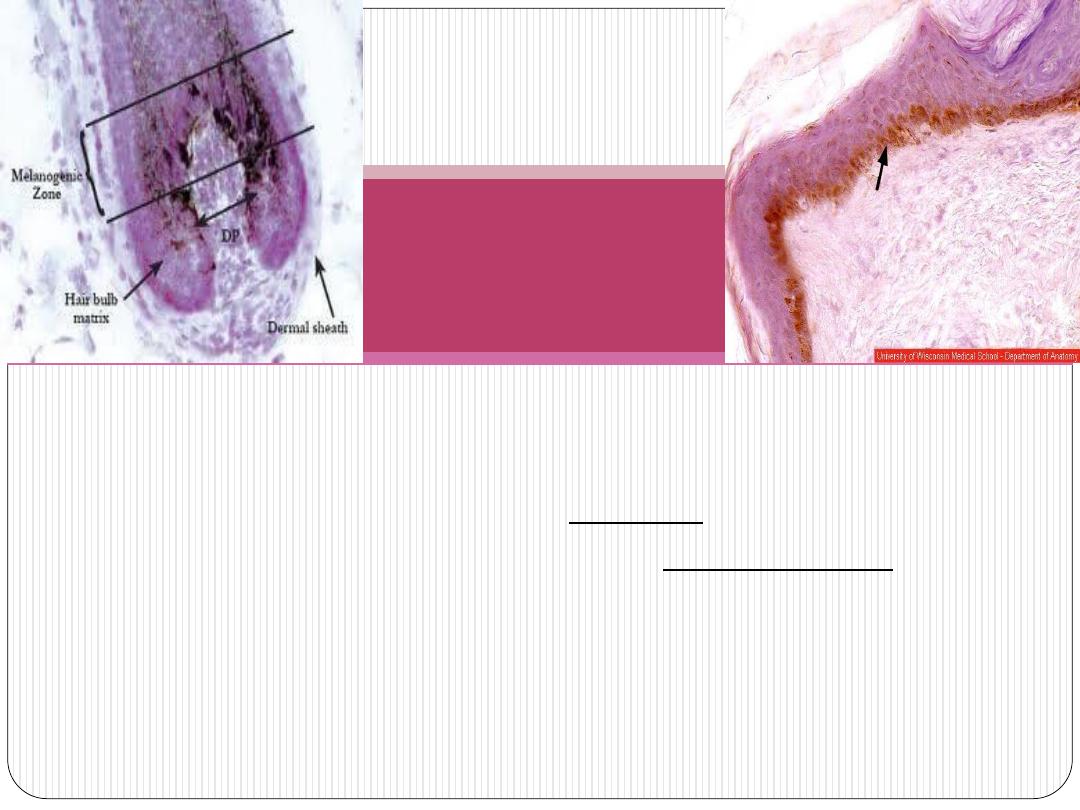
(1)specialized cells of the epidermis found among the cells of
stratum
basale
and in the
hair follicles
.
(brownish black
melanin
they synthesize
)From tyrosine,
2
(
melanosomes
pigment ) and store it in vesicles called
(3)They are
neural crest
derivatives which migrate into the
developing epidermis' stratum basale.
Melanocytes
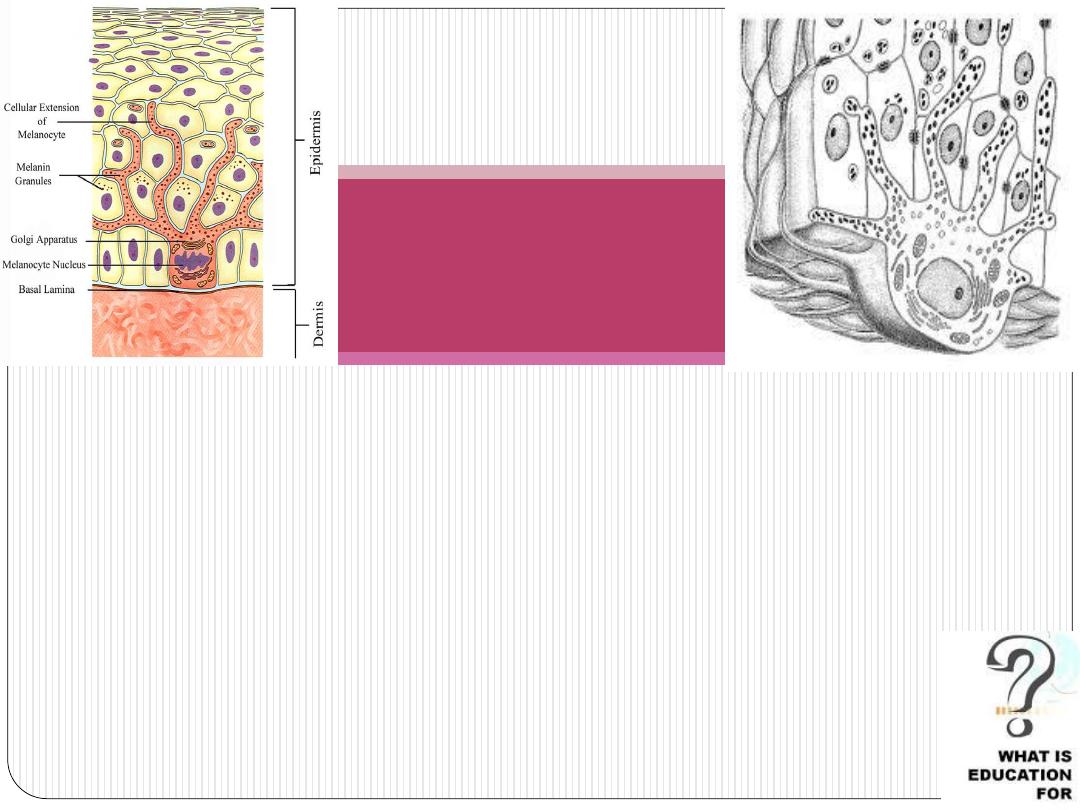
(4)They have
rounded cell bodies
and long irregular
dendritic extensions
from each melanocyte branch into the
epidermis, running between the cells of the basal and
spinous layers.
(5)They form
hemidesmosomes
with the basal lamina, but no
desmosomes with adjacent keratinocytes.
(6)Ultrastructurally, a melanocyte is a pale-staining cell with
numerous small mitochondria, short cisternae of rough
endoplasmic reticulum (RER), and a well-developed Golgi
apparatus.
Melanocytes
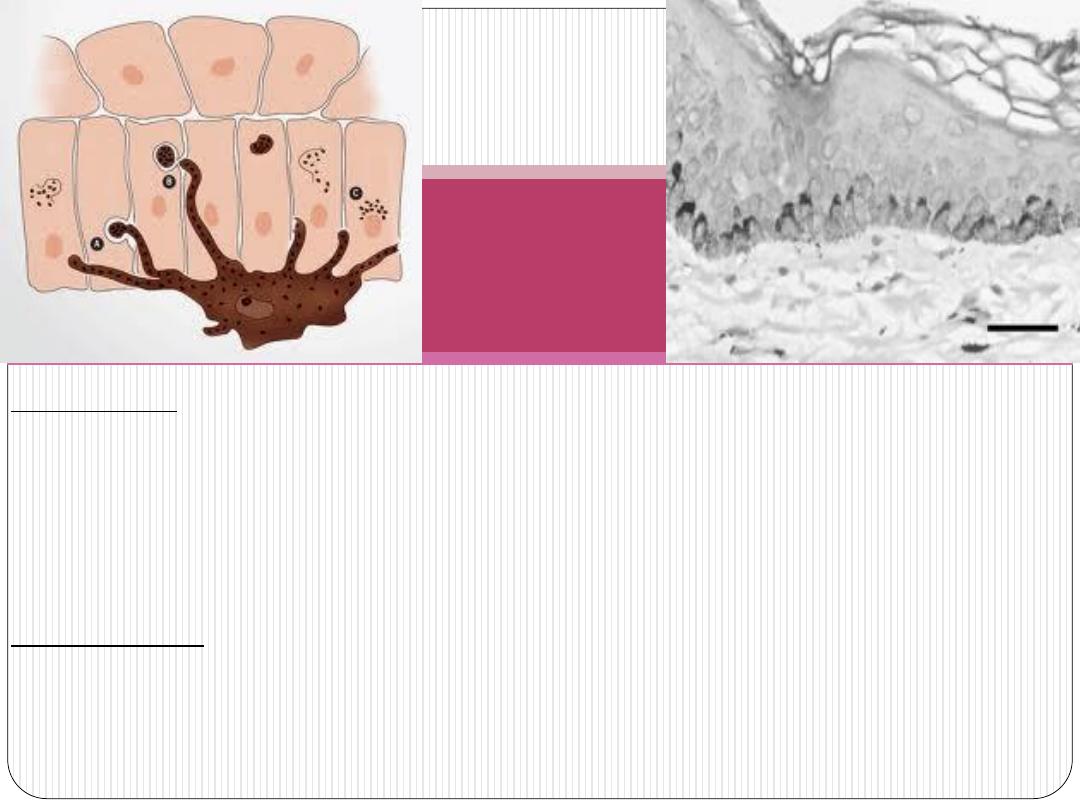
.
melanocytes
converts tyrosine into melanin within
Tyrosinase
Melanin accumulates in vesicles until they form mature granules
called
melanosomes
.
Once formed, melanin granules are transported to tips of the
melanocyte's dendrites.
The associated keratinocytes in both the basal and spinous layers
the tips of these dendrites.
phagocytose
Within each keratinocyte they accumulate as a
supranuclear cap
which absorbs and scatters sunlight, protecting nuclear DNA from
the deleterious effects of UV radiation.
Melanin
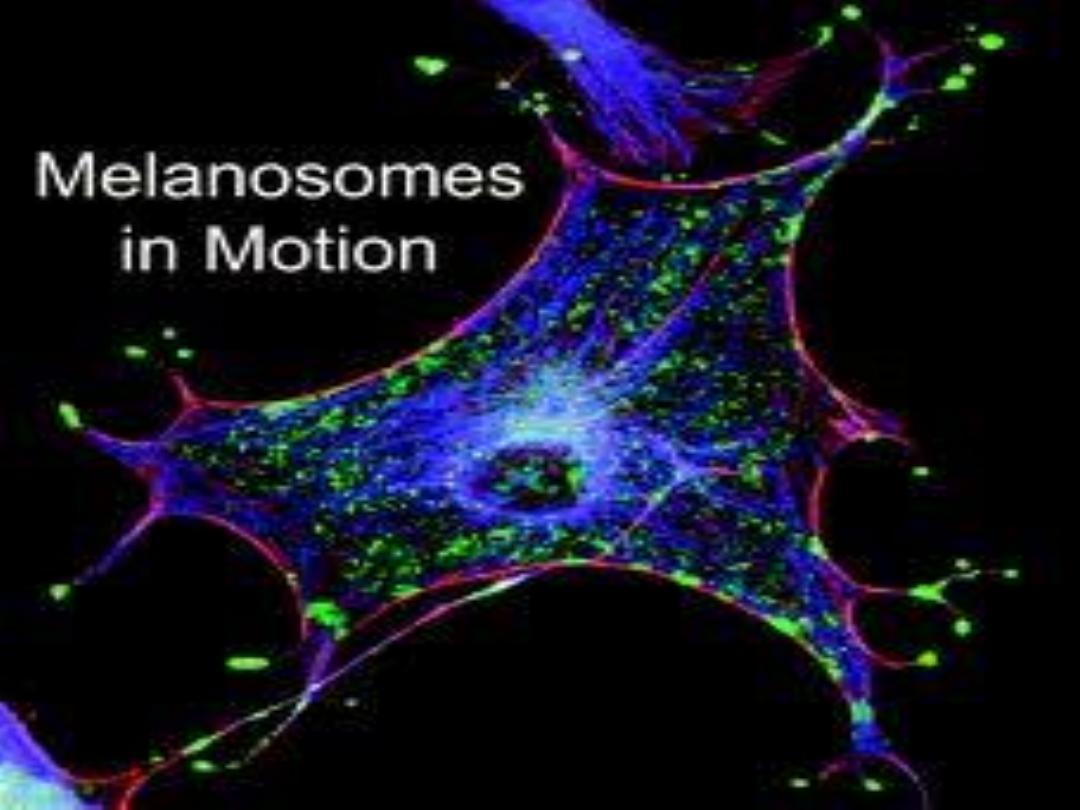

the result of several factors,
(1)the most important of which are
melanin
' content of
keratinocytes
the
carotene
)
2
(
in the
blood vessels
) the number of
3
(
dermis
Color of the skin
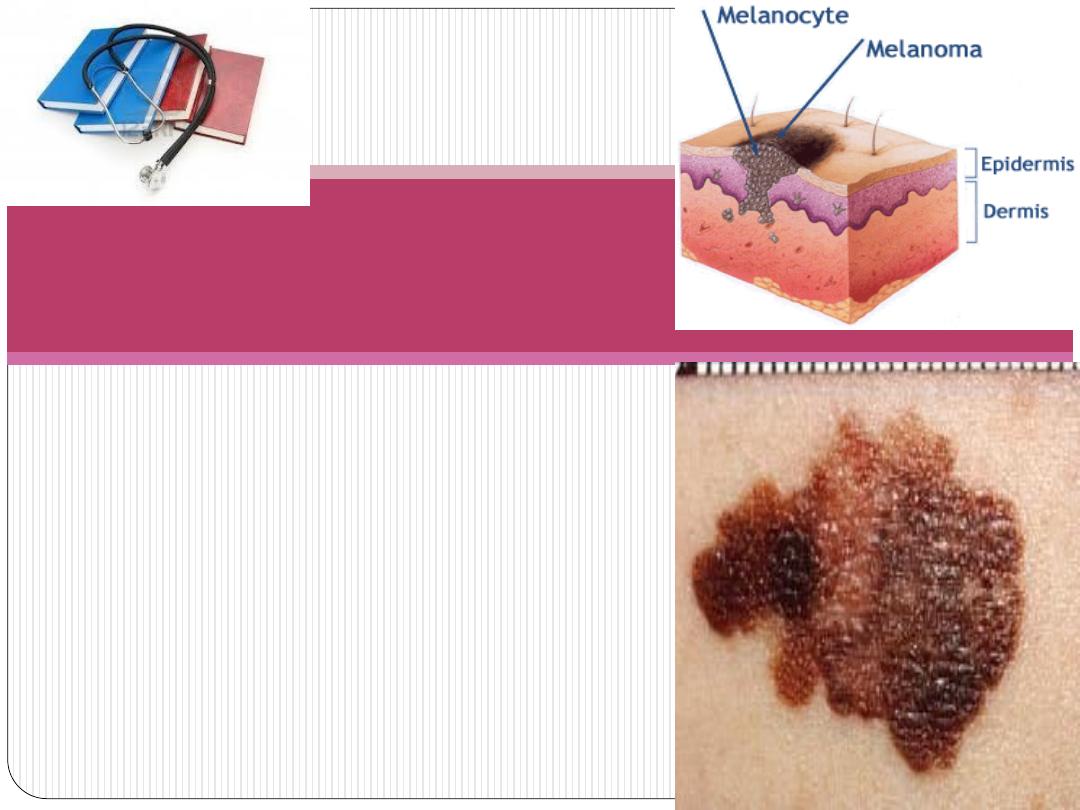
Malignant melanoma is an invasive
tumor of melanocytes. Dividing rapidly,
malignantly transformed melanocytes
penetrate the basal lamina, enter the dermis,
and invade the blood and lymphatic vessels to
gain wide distribution throughout the body.
MEDICAL APPLICATION
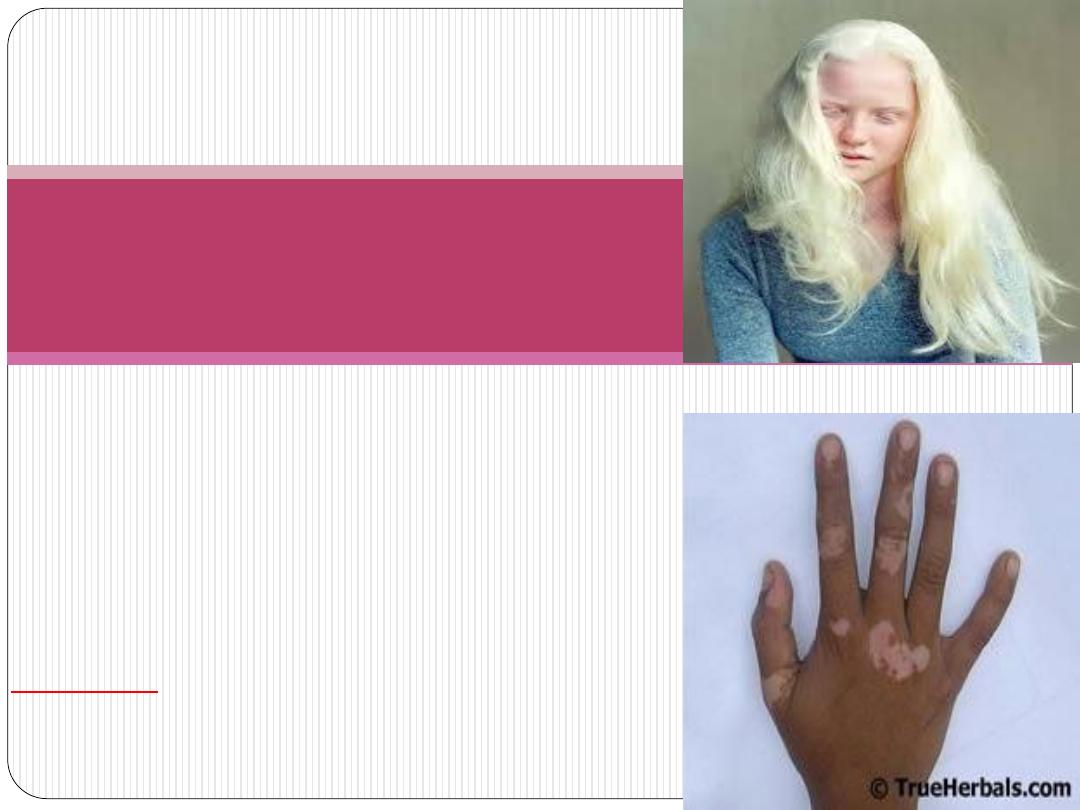
Albinism
, a hereditary inability of the
melanocytes to synthesize melanin, is caused by the
absence of tyrosinase
activity or the inability of cells to
take up tyrosine. As a result, the skin is not protected
from solar radiation by melanin, and there is a greater
incidence of (skin cancers).
The
degeneration and disappearance of entire
causes a patchy loss of pigment in the skin
melanocytes
disorder called
vitiligo.
MEDICAL APPLICATION

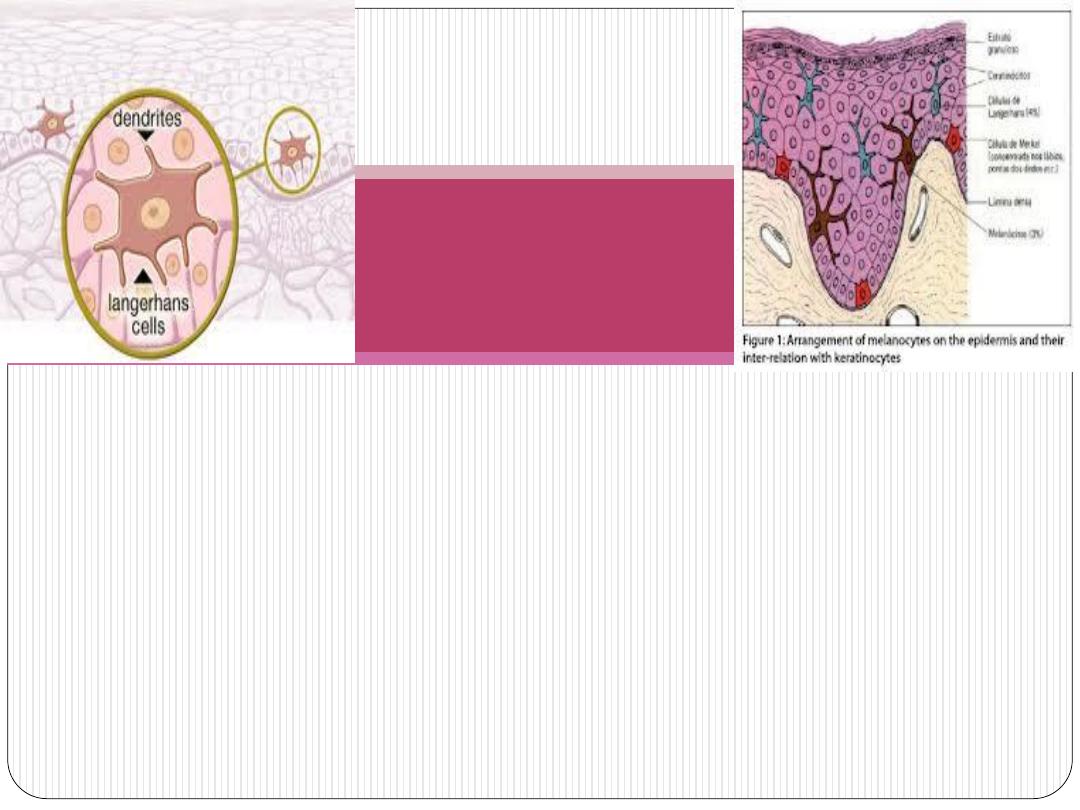
(1)usually most clearly seen in the
spinous
layer.
(2)
Cytoplasmic processes
extend from these dendritic cells
between keratinocytes of all the layers, forming a fairly dense
network in the epidermis .
(3)They are bone marrow–derived.
(4)capable of binding, processing, and
presenting antigens
to T
lymphocytes, thus providing an immunological component to
the skin's overall
protective
function
.
Langerhans
Dendritic Cells
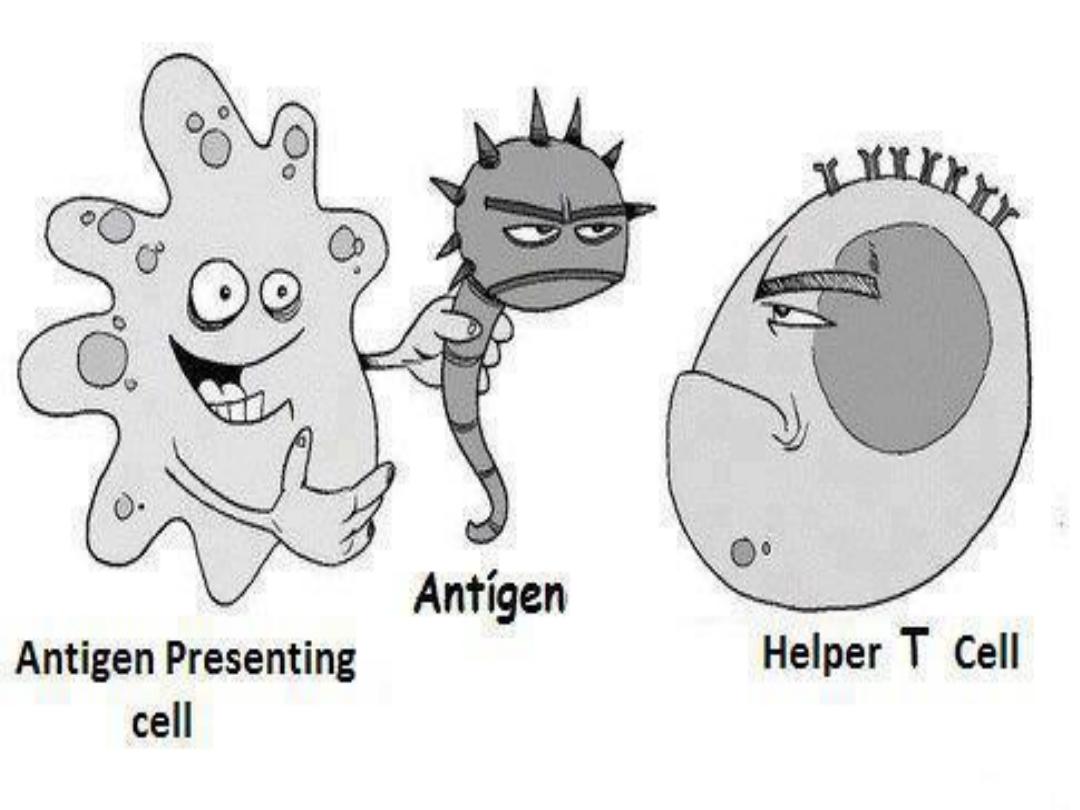
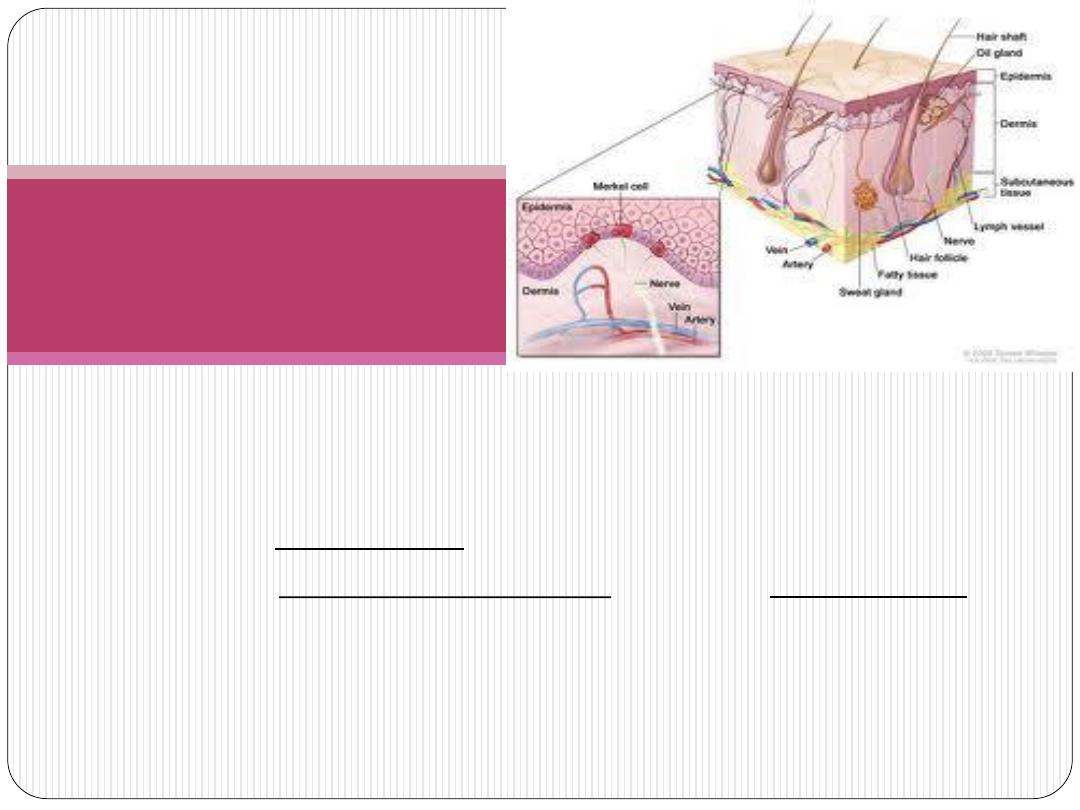
(1)
mechanoreceptors
(sense of touch)
(2)Small
neurosecretory granules
(related to diffuse neuroendocrine
system)
cells
neural crest
)Derived from
3
(
bases of hair
and at the
basal epidermal layer
) located in the
4
(
follicles.
(5)The basolateral surfaces of the cells contact expanded terminal
discs of
unmyelinated sensory fibers
that penetrate the basal lamina.
Tactile (Merkel)
Cells
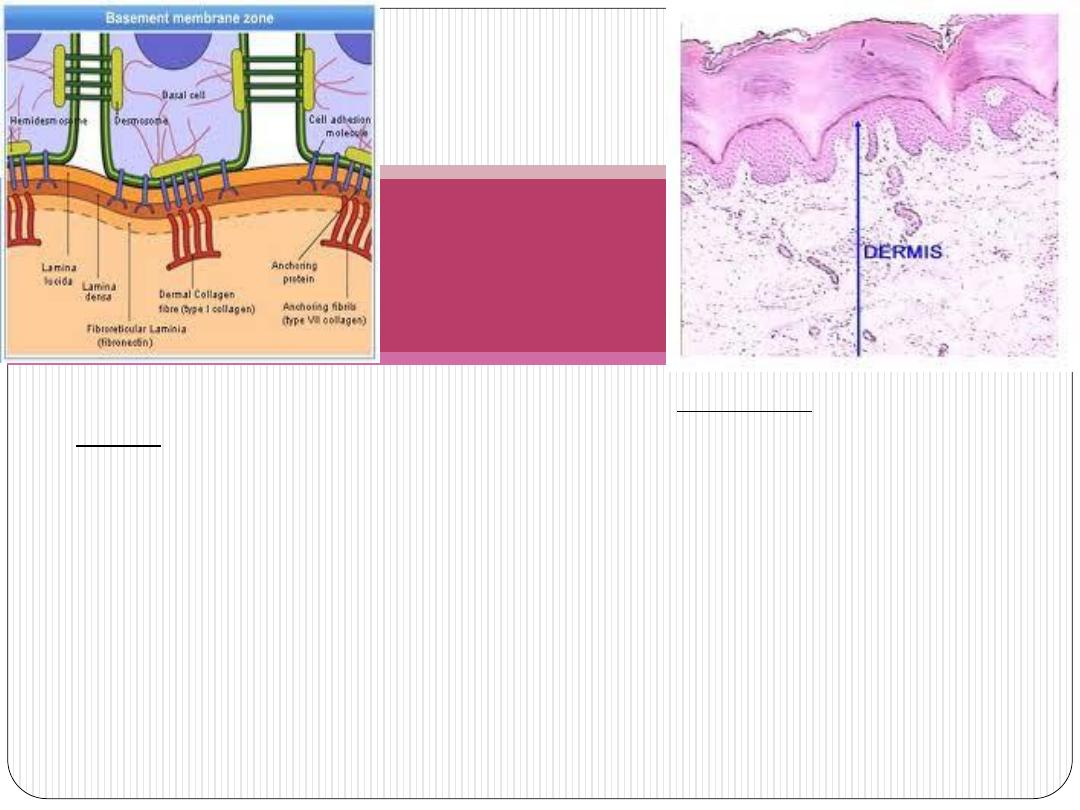
the epidermis
supports
, that
connective tissue
)The dermis is the
1
(
it to the subcutaneous tissue (hypodermis).
binds
and
(2)The thickness of the dermis varies according to the region of the
body, and reaches its maximum of 4 mm on the back.
(3)A
basement membrane
is always found between the stratum basale
and the dermis.
(4)The basement membrane consists of the
basal lamina
and the
reticular lamina
and can usually be seen with the light microscope.
(5)Nutrients for keratinocytes must diffuse into the avascular
epidermis from the dermis vasculature through this basement
membrane.
Dermis
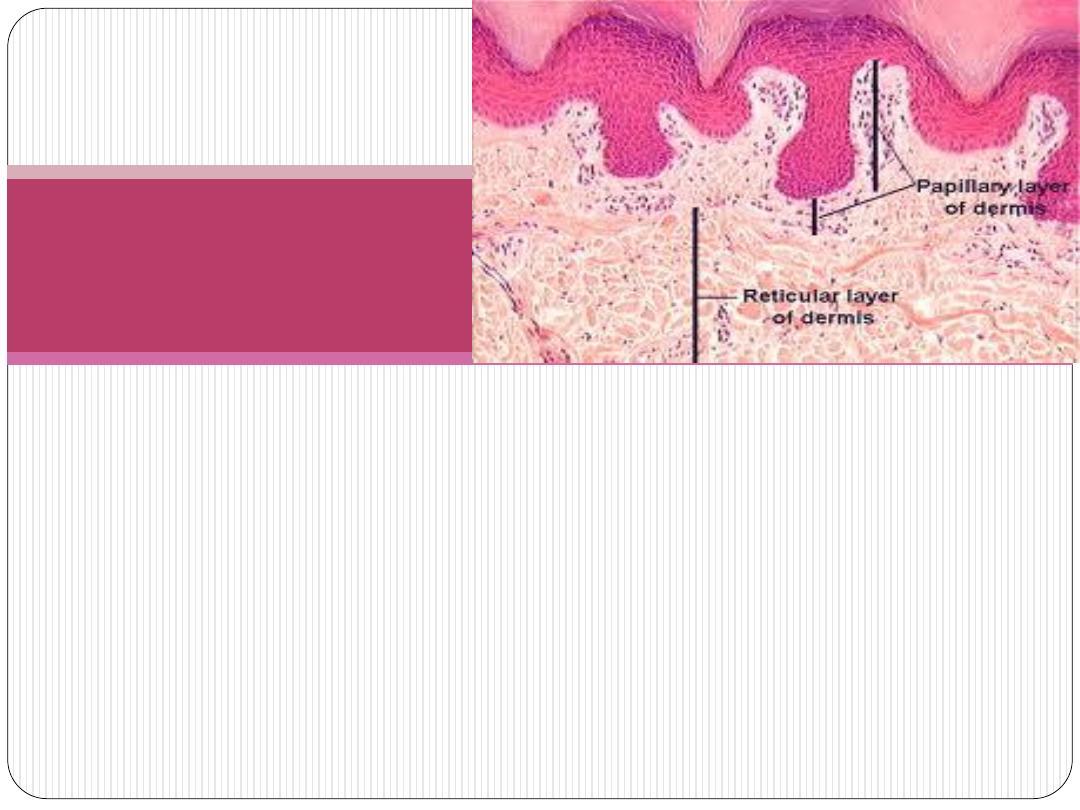
The dermis contains two layers with rather indistinct boundaries:
(1)The thin
papillary layer
, which constitutes the major part of the
dermal papillae, is composed of loose connective tissue, with fibroblasts
and other connective tissue cells, such as mast cells and macrophages.
Extravasated leukocytes are also seen. From this layer, anchoring fibrils of
type VII collagen insert into the basal lamina and bind the dermis to the
epidermis.
(2)The
reticular layer
is thicker, composed of irregular dense
connective tissue (mainly bundles of type I collagen), and has more fibers
and fewer cells than the papillary layer. A network of elastic fibers is also
present, providing elasticity to the skin. Spaces between the collagen and
elastic fibers are filled with proteoglycans rich in dermatan sulfate.
Dermis

, collagen fibers thicken and collagen synthesis decreases. Elastic fibers
age
)With
1
(
steadily increase in number and thickness, so the elastin content of human skin
increases approximately fivefold from fetal to
adult life
.
In
old age
, extensive cross-linking of collagen fibers, the loss of elastic fibers, and
degeneration of these fibers due to excessive exposure to the sun (solar elastosis)
cause the skin to become more fragile, lose its suppleness, and develop wrinkles.
(2)In
Ehlers-Danlos syndromes
, there is a considerable increase in skin and
ligament extensibility caused by defective collagen-fibril processing.
.
MEDICAL
APPLICATION
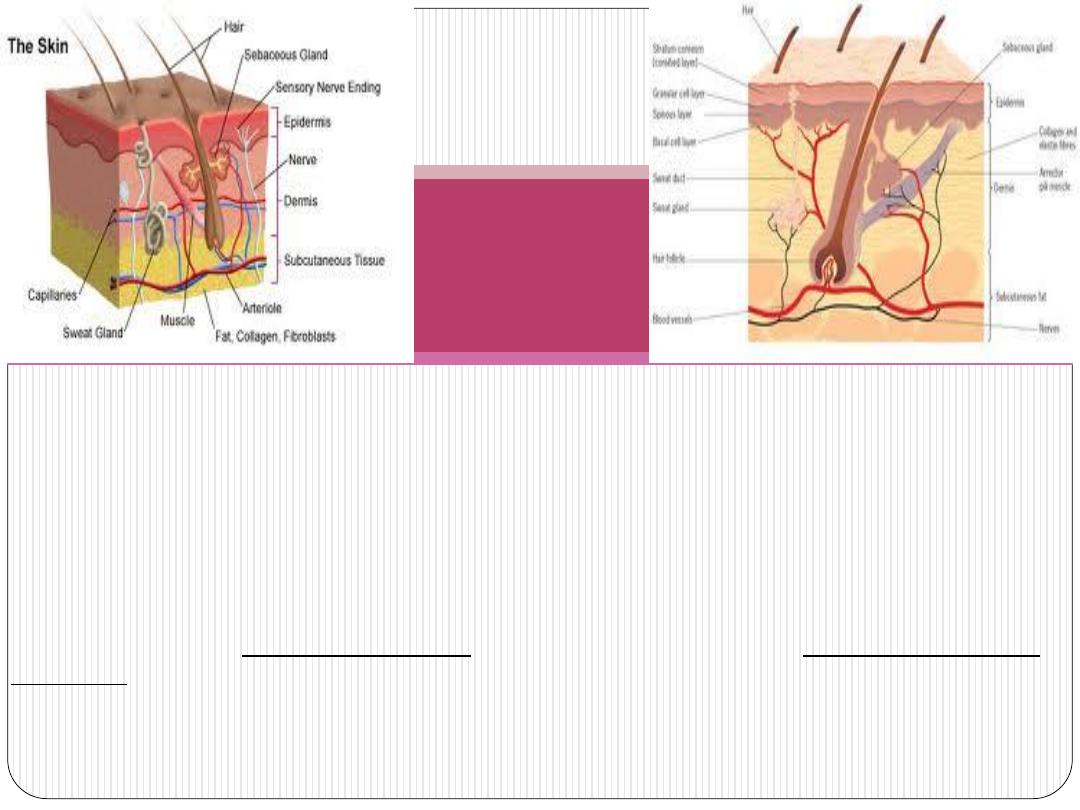
The connective tissue of the skin contains a rich network of blood and lymphatic
vessels.
Blood vessels
that nourish the cells of skin form two major plexuses :
(1) deep at the interface between hypodermis and dermis
(2)superficially between the papillary and reticular dermal layers (
subpapillary
plexus)
sends branches into the dermal papillae and supplies a rich, nutritive
capillary network just below the epidermis.
thermoregulatory
, dermal vasculature has a
nutritive function
In addition to the
located between
anastomoses
arteriovenous
which involves numerous
function
the two major plexuses.
Lymphatic vessels
begin as closed sacs in the dermal papillae and converge
to form two plexuses located with the blood vessels.
Vessels
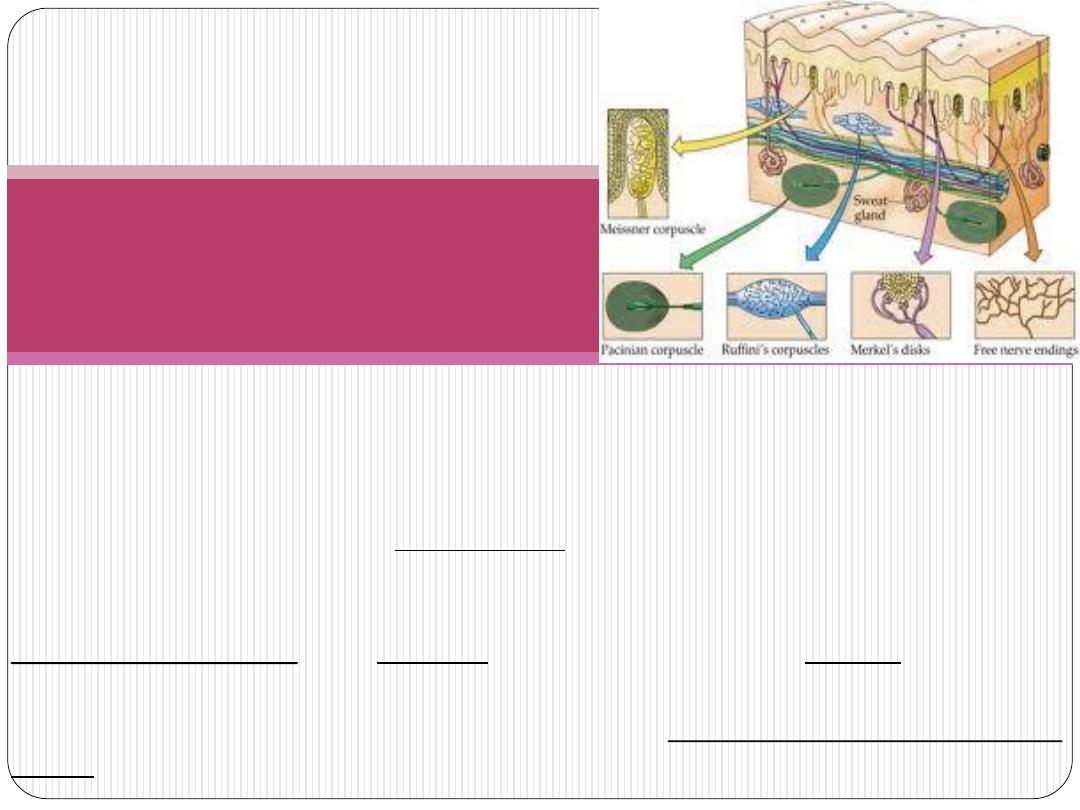
sensory receptors are present in skin, including
The
unencapsulated receptors
include the following:
(1)
Tactile discs
associated with the epidermal tactile cells, which
.
light touch
function as receptors for
(2)
Free nerve endings
in the papillary dermis and extending into
lower epidermal layers, which respond primarily to high and low
receptors.
tactile
, but also function as
itching
, and
temperatures, pain
(
3)Root hair plexuses
, a web of sensory fibers surrounding the bases
detects movements of the
of hair follicles in the reticular dermis that
hairs.
Sensory Receptors
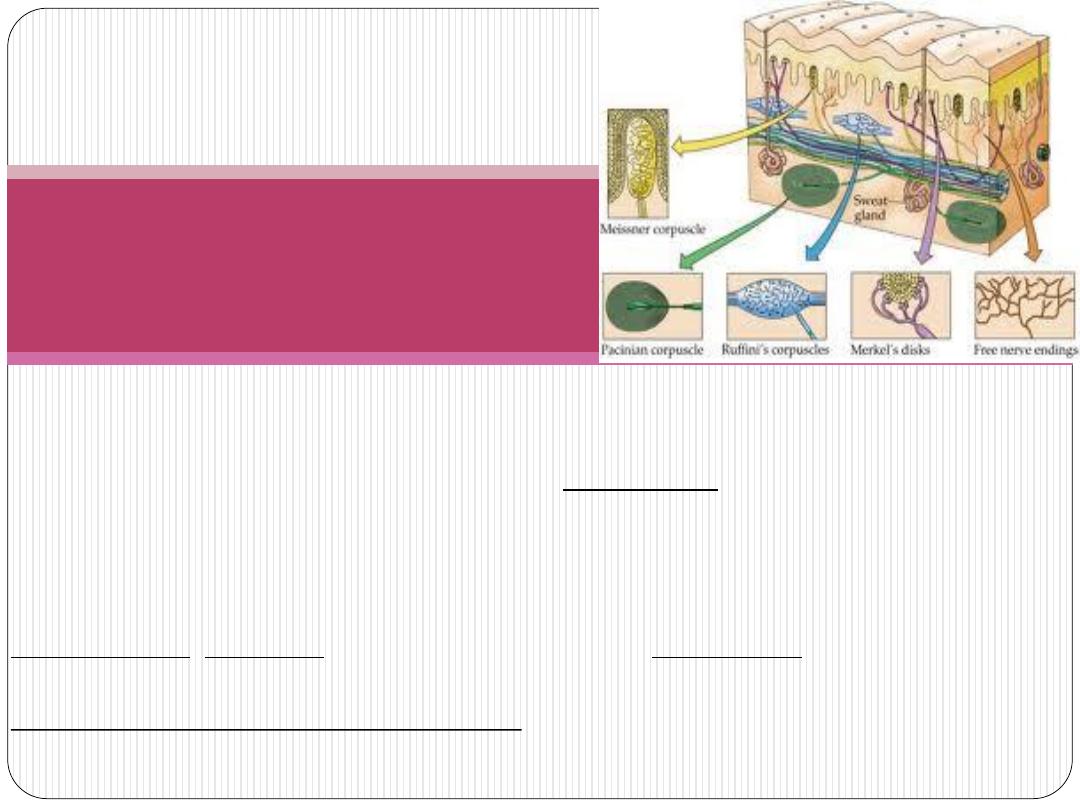
The following
encapsulated receptors
are tactile mechanoreceptors:
(1)
Tactile corpuscles (Meissner corpuscles
) are elliptical structures, in the
.
light touch
fingertips, palms and soles. They detect
(
2)Lamellated (Pacinian)
corpuscles are large oval structures, found deep in
the reticular dermis or hypodermis, with an outer capsule and 15 to 50 thin,
concentric lamellae of flat Schwann-type cells and collagen surrounding a
highly branched, unmyelinated axon. They are specialized for sensing
vibrations.
(sustained touch), and
pressure
,
coarse touch
(
3)Krause corpuscles
and
Ruffini corpuscles
are other encapsulated,
in dermis, but are more poorly
sensing mechanoreceptors
-
pressure
characterized structurally
Sensory Receptors


Any Question???


Nails



















